#my thinking on revolutionary politics in the last several years has become focused on the idea that the inherent singular goal
Explore tagged Tumblr posts
Text
i’ve made this post and argued about this before but i don’t get if you’re a revolutionary (of basically any stripe) why you would oppose mandatory military service—what could possibly be better than the state paying for training your future cadres and the people being just one seized armoury away from resembling an actual force—the point of all revolutionary movements is to start and win a civil war and somehow the volunteer service model is going to make that easier
also obviously conscripts are going to be easier to radicalise into defection than volunteers, which is generally going to be critical to your civil war victory
#there’s many worse and more personal versions of this post in my drafts across the past couple years#my thinking on revolutionary politics in the last several years has become focused on the idea that the inherent singular goal#of any revolutionary movement is to start and win a civil war#for good or ill idk how it can be separated from that core#draftposting apropos of recent discussion
201 notes
·
View notes
Text
No Power Left to the Vanquished
My feelings, Conscript Fathers, are extremely different, when I contemplate our circumstances and dangers, and when I revolve in my mind the sentiments of some who have spoken before me. Those speakers, as it seems to me, have considered only how to punish the traitors who have raised war against their country, their parents, their altars, and their homes; but the state of affairs warns us rather to secure ourselves against them, than to take counsel as to what sentence we should pass upon them. Other crimes you may punish after they have been committed; but as to this, unless you prevent its commission, you will, when it has once taken effect, in vain appeal to justice. When the city is taken, no power is left to the vanquished.
- Sallust, quoting Cato the Younger, Bellum Catilinae

In the late years of the Roman Republic, a conspiracy arose from within the ranks of the Senate. The aristocrat Lucius Sergius Catilina attempted to seize control of the government after his bid for consulship failed. One of the consuls, Cicero, exposed the conspiracy and Catilina fled Rome to prepare an army. Five of the conspirators were captured after the letters they wrote, in which they urged people to join the conspiracy, were intercepted. The letters were read before the Senate and Cicero urged for the execution of their authors.

Julius Caesar pled for patience and clemency; after all, Rome had laws and customs to observe. He did not want to set a precedent that the ways of Rome could be set aside because they were inconvenient. Cato the Younger, a longtime (and future) opponent of Caesar, spoke next. His appeal won out because the Senate understood the reality of the scenario he was describing: when an institution is in imminent danger from those who seek to dismantle it, you must question if strict adherence to the institution’s laws and customs is worth more than the existence of the institution itself.
Fourteen years later, Julius Caesar, champion of Roman laws and customs, crossed the Rubicon in defiance of law, custom, and the explicit order of the Senate to mark what would become the end of the Roman Republic and the beginning of Caesar’s rule of the Roman Empire. Caesar’s respect for Roman norms and civitas ended when they put him in personal danger. As for Cato, he died with the republic and subsequently became its most lionized martyr.
In 1923, Adolf Hitler and Erich Ludendorff, accompanied by hundreds of other Nazis and members of the paramilitary Sturmabteilung staged the Beer Hall Putsch, an attempted coupe d'état against the regional Bavarian government. Hitler’s goal was to pressure the elected representatives in Munich to turn against the federal government in Berlin through a public show of force and violence. It failed. Hitler was imprisoned, but he used his trial testimony to continue spreading his propaganda and dictated Mein Kampf while serving his sentence. The Beer Hall Putsch was a success for the Nazi party in spite failing to achieve Hitler’s goals.
Ten years later, Hitler was the presidentially-appointed Reichskanzler of Germany. While the Nazis had the most seats in the Reichstag, it was still a minority party. To ensure the passage of the Enabling Act, which gave the chancellor the power to enact laws without the involvement of the Reichstag, Hermann Göring, President of the Reichstag, suspended the rules for quorum and outlawed the opposition KPD (Communist party) from participating. Sturmabteilung forces entered the assembly chamber to surround and intimidate the non-Nazi representatives into voting for the law. The passage of the Enabling Act marked the end of the Weimar Republic and the beginning of Hitler’s dictatorship over the German Reich.
The differences between the Beer Hall Putsch and and the Enabling Act were differences of organizational power, instruments, and outcome, not intent. In both cases, the same bad actors were seeking to overthrow an existing government. President Paul von Hindenburg and Franz von Papen failed to recognize that Hitler and the Nazis not only threatened the principles of the aristocracy or their other political opponents, but the Weimar Republic itself.
Was the Weimar Republic worth saving? It was, by most accounts, including the little my grandmother remembered of it, an awful state. Its government was, putting it mildly, dysfunctional. Many of its citizens lived through an era of terrible poverty and violence following the end of the first World War. But the Reich is what came after. All other avenues of evolutionary institutional or truly revolutionary change ended with the fall of the republic. The world suffered for it.
Trump and his allies have been attacking American institutions for the last four years. Trump doesn’t have the ideological drive of Hitler or the strategic acumen of Caesar. He just has the most base populist instincts to agitate a mob. What he shares with Hitler, Caesar, and other would-be dictators is a desire to remove opposition and the institutional mechanisms of opposition through whatever means are at his disposal. If he can do it through an executive order, he will. If he can do it through political pressure, he will. If can do it through intimidation, quid pro quo exchanges, and other illegal actions, he will. And if it requires a mob of supporters to storm the capitol during a Senate session to overturn their certification vote, he’ll try use that, too.
People have been likening what happened in the U.S. capitol to the Beer Hall Putsch. It’s a fair and reasonable comparison, though Hitler did actually march in his own coup attempt and was wounded during its defeat; Trump just gathered people together, lit a fuse, and watched them go. But it’s important to remember that the differences between the Beer Hall Putsch and the Enabling Act were of organizational power, instruments, and outcome. What if there had been more pro-Trump agitators at the capitol? What if the Senate had not been evacuated in time? What if Trump had more supporters within the Senate to begin with?�� What if Trump were even mildly more intellectually competent or the various online factional leaders in his mob were more coordinated in their tactics and goals?
Facebook, twitter, and other social media sites have deplatformed Trump. Several companies have suspended hosting services for online communities that have been involved in coordinating fascist, white supremacist mobs in the past. Trump’s supporters, in ignorance or bad faith, have decried that this violates 1st Amendment rights. They are wrong, but even if they were not, the events of January 6th, planned armed protests on the 17th, and threats of violence against Biden’s inauguration on the 20th, represent the kind of imminent institutional danger that Cato spoke of during the Catiline Conspiracy. “When the city is taken, no power is left to the vanquished.”
We have wrestled with how the government and corporations should moderate social media since these platforms emerged. We will continue to do so in the future. While we must take guard against the transformation of severe actions in time of crisis into the de facto way of handling our day-to-day problems, we must also recognize and act to resolve crises as soon as they appear if we have any interest in preserving the institutions they threaten.
I think of myself as a socialist. My political thought is not as educated, as principled, or as nuanced as many other socialists I know, some of whom think that any efforts to preserve or work within existing American institutions is, at best, naïve; in practice, counterproductive; and, at worst, actively reactionary. I often look at our institutions through the lens of a designer. When I do, I see systems that do not work to produce meaningful social change. I see systems which do not often work to accomplish any goals of its body politic. In practice, our systems serve the needs and interests of the ruling class and the powers that have the means and knowledge to manipulate the members of that class. The systems confine the use of violence and its instruments to the state, as the state sees fit, often to the detriment and mortal peril of the most disadvantaged and vulnerable among us. It is hard for me to sympathize with those who deify the state and its institutions, especially a state like America that treats its citizens so cruelly. It becomes even harder when adjacent political cousins perennially denounce any hesitance to support milquetoast centrist candidates as tantamount to treason. Even so, when fascists, white supremacists, advocates of genocide are positioning themselves to imminently dismantle these institutions through intimidation and violence, it is not difficult for me to see the value in their immediate preservation.
But if the state and its institutions do survive the next few weeks, we will still live in a world where social media and the principles of freedom of speech are vulnerable to the predations of those who would use their contentious legal status to spread lies, foment popular dissent, and, if necessary, coordinate another violent coup d'état when the time is ripe. The next time, perhaps the popular figurehead will not be as ignorant, as incompetent, as craven, as plainly stupid as Donald Trump. You can already see his would-be successors positioning themselves for 2024 in the waning hours of his presidency. The next time, the populist agitators may be more focused in their goals, more coherent in their strategy, more careful in their communication. Those among them who have witnessed the spectacular failure of imbeciles like Jake Angeli, Adam Johnson, and Richard Barnett may be shrewd enough to learn from the disaster as they prepare for the future.
The Weimar Republic became vulnerable to the schemes of the Nazi party because its representatives failed to address the needs of its citizens and because its leaders failed to recognize the magnitude of threat posed by leaders like Adolf Hitler, propagandists like Goebbels, and paramilitary groups like the Sturmabteilung. Our elected representatives may have finally, at this recent brink of disaster, comprehended the threat that Trump and his supporters pose to the existence of the state. After they make their way through January 20th, the federal government will have to address the needs of a disaffected, impoverished, violently-policed, often disenfranchised populace. They will also have to disentangle the mess that the government has created through their laissez-faire attitude toward social and news media regulation. Their actions in the immediate future will tell if they intend to effect meaningful change or if they are content to use the next four years to pave a road to the ruin of the republic.
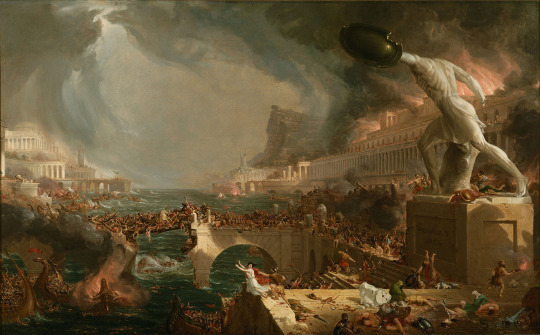
549 notes
·
View notes
Link
Carlos Muñoz, Jr. remembers when he first began to ponder the meaning of his Mexican roots.Muñoz, now 80, was living in the crowded Segundo barrio of El Paso, Texas. His family—like thousands of other émigrés—had settled there decades earlier, refugees fleeing violence spawned by the Mexican Revolution.Neither of his parents had made it past elementary school, but they wanted more for their son. So young Carlos walked across town every day to an Anglo neighborhood where the local school had more resources than barrio campuses.In that world, Carlos became Charles—rechristened in fifth grade by a white teacher in an attempt to “Americanize” him.
His school records were altered to label him Charles. But nothing else about him changed. “I began to wonder about what that meant,” he recalls. “That was the first time that I started thinking about identity and culture and that kind of stuff.”
It wouldn’t be the last.
The next year his family moved from El Paso to Los Angeles, where they hopscotched among barrios from the Eastside to Downtown to South Los Angeles. And no matter whether his teachers called him Carlos or Charles, their ingrained attitudes about his Mexican heritage narrowed his path.
The counselors at Belmont High School steered Charles away from college prep and toward vocational ed, even though he was an honor student. They suggested he become a carpenter, like his dad.

“If you were Black or Brown and a male at that time, you automatically got to be an industrial arts major,” he says. “You take the basic courses in English, history and government, but you don’t get the algebra and the biology courses.”
He didn’t realize until after he graduated with honors in 1958 that those courses he missed were required for admission to California’s public universities.
It would take six years for Charles to navigate a route—through community college, military service and a white-collar job that paid well but left him unfulfilled—to the campus of Cal State LA.
There, in the midst of a nascent Chicano rights movement, Charles reclaimed Carlos and played a key role in a history-making venture that would create new paths for Latino students: the creation at Cal State LA of the first Mexican American Studies program in the nation.
Its launch five decades ago—which Muñoz, then a graduate student, helped lead—would usher in a new era of ethnic studies across the Southwestern United States and ultimately around the country. Today more than 400 universities have programs dedicated to the study of the history, circumstances and culture of Latinos in America.
“Right now, there’s an awareness of ethnic studies. … But the beginnings of ethnic studies, as a discipline, were right here at Cal State LA,” says Professor Dolores Delgado Bernal, chair of what is now the Department of Chicana(o) and Latina(o) Studies.
“The discipline offers a lot to students, in terms of their identities, their intellect, what interests they pursue. Taking these courses allows students to say, ‘I can claim and be proud of who I am, and that allows me to better understand and accept others who are not like me.’ ”
“It’s becoming increasingly important to have that interdisciplinary background, and an understanding of other cultures and races,” Delgado Bernal says.
Today Muñoz is a professor emeritus in the Department of Ethnic Studies at UC Berkeley. He’s an author, political scientist, historian and scholar, specializing in social and revolutionary movements.
But the challenges Muñoz encountered on his journey from the barrio to the ivory tower typify the struggles that many Latino students still face today—and illustrate why Chicano Studies was necessary decades ago, and still has an important role to play.
In its early years, the Cal State LA program was a resource for local students who felt intimidated by college and invisible on campus.
The spotlight on Chicano history and culture allowed them to see themselves through a new lens, one scrubbed of stereotypes. And its sweeping scope connected them to other marginalized groups, illuminating struggles for equality that students found ultimately empowering.
“To me, the thing about Chicano Studies is that it was eye-opening to the truth and history,” Carmen Ramírez, an Oxnard city councilwoman who attended Cal State LA for two years in the 1970s, says. “If you don’t know the truth, you can’t fix the future. … We need to know our history.”
And the dividends spread far beyond the campus, the student body and local communities. By its very existence, the Cal State LA program gave national credibility to the concept of ethnic studies as an intellectual pursuit.
“Chicano Studies opened the door to possibilities of employment on university faculties,” said Raul Ruiz, professor emeritus in the Department of Chicana and Chicano Studies at Cal State Northridge, which hired him in 1970. He earned a bachelor’s degree from Cal State LA in 1967, and went on to earn his master’s and Ph.D. at Harvard. Ruiz died this year at 78 years old.
“Chicano Studies gave us opportunities to teach at the college level. And that was very significant in an era when many of us never had a Latino professor.”
At that time, “there were only about five Mexican Americans in the country with Ph.D.s in the social sciences,” recalls Muñoz, who earned his B.A. in political science from Cal State LA and a Ph.D. in government from the Claremont Graduate School.
Like Ruiz and Muñoz, several of the campus movement’s leaders went on to become college professors and scholarly experts in the field.
But even when they were offered faculty positions in Latino Studies, their contributions were often minimized or disregarded.
“Now we’re very visible at universities across the nation,” Muñoz says. “But during my career, I often had to face that perspective— you’re just ideologues, not scholars—from conservative faculty. It was not an easy path.”
For students like Ruiz, the path was equally challenging.
Ruiz had moved to Los Angeles from El Paso as a child in the 1950s. Told he wasn’t “college material,” Ruiz enrolled in Trade Tech, studied mechanical drawing and took a job drafting engineering plans for aviation systems. A year of that made him miserable, so he quit and in the mid-’60s applied to Cal State LA as an English major.
Then, as now, the Cal State LA campus was walking distance from one of the largest urban Mexican American communities in the United States. But few students in that community were being prepared for college.
The university experience seemed so remote that Eastside parents who could see the hillside campus from their yards thought “the building on the hill was the Sybil Brand Institute” for incarcerated women, Cal State LA Professor Ralph C. Guzmán told the University’s College Times newspaper in 1968.
Guzmán, who helped draft early Chicano Studies proposals, was one of just a handful of Latino faculty members then.
Ruiz was the only Mexican American kid in most of his classes, he said.
“I remember as an English major, the sense of me being up against everything. I remember making a presentation and the other students came at me hard with criticism,” Ruiz said. “I remember saying to myself, ‘Next time you’re going to know more than everybody else.’ ”

Ultimately, that would motivate him to develop a rigorous background in research. But as a new student, he found the social isolation to be a destabilizing experience.
After a professor told him he was smart “but basically illiterate,” Ruiz spent hours alone in the library—after classes and before his post office job—teaching himself to write.
“I would practice writing sentences and improving them until I could write a paragraph, and then an essay,” he said. It took him six months to develop the skills he needed. The skills he should have been taught in high school.
Cal State LA already had a robust interdisciplinary program of Latin American Studies, with classes that focused on Mexican culture but had little connection to the American experience.

“It was a marvelous program. It opened up my consciousness,” Ruiz said. But he came to realize that he knew more about Mexicans in Mexico than he did about families like his, “Mexicans in my own community.”
Beyond the University, in his own community, unrest and outrage were brewing. Mexican Americans had found their voice and were beginning to challenge the status quo. And nowhere did that coalesce more vividly than in the neighborhoods around Cal State LA.
“It was actually right here in the city of Los Angeles where the Chicano movement started,” noted legendary civil rights leader Dolores Huerta, when she visited campus to celebrate the 50th anniversary of Chicano Studies in September 2018.
The Chicano Studies program helped empower young activists and bring national attention to the challenges and concerns of Mexican Americans, she said.
Ruiz remembered what that felt like. “We were becoming part of this growing social movement that was sweeping the country, with massive anti-war protests and civil rights marches,” he recalled.
Community organizers rallied Eastside families to join the demonstrations. Student groups on campus worked together behind the scenes for change.
“I was not a radical person,” Ruiz said. “But you couldn’t help but become involved, or at least think about it.”
In March 1968, that awareness came to a head, as thousands of students at five high schools within a six-mile radius of Cal State LA walked out of classes and took to the streets, to challenge an educational system that didn’t recognize their worth or value their needs.
Thirteen adults would be arrested, jailed and charged with conspiracy for helping organize the walkouts. Muñoz—who’d proudly changed his name back to Carlos—was among them.
By then Muñoz was a Cal State LA graduate student and a U.S. veteran, who understood why students were walking out. The kid whom counselors steered away from college prep classes in high school was now on his way to becoming a university professor—and he was on the front lines of the battle to improve education for younger Latinos.
Police arrested Muñoz at gunpoint three months after the walkouts, as he sat at the kitchen table in his apartment doing his political science homework, and his wife and two young children slept upstairs. Muñoz spent two years on bail and faced a possible prison term of 66 years, until an appellate court dismissed the charges as a violation of the defendants’ First Amendment rights.
The walkouts alarmed the educational establishment, but energized the local community and moved education to the front of an activist agenda.
Cal State LA students, faculty and administration partnered with community groups to help broaden opportunities.
That summer Cal State LA’s student government voted to allocate $40,000 for an Educational Opportunity Program that would provide the support needed by students who were motivated but underprepared. Sixty-eight Latino and Black freshmen were admitted through the program that first year.
And University leaders agreed to work with student activists to get the Chicano Studies program up and running. The pioneering program was launched in the fall of 1968—with four courses and funding from student government.
Muñoz wound up teaching the program’s introductory course in the fall of 1968: Mexican American 100. Graduate student Gilbert Gonzalez taught Mexican American 111, a course on Mexican American history, and Professor Guzmán taught two upper-division classes.
“I was a first-year grad student in political science,” Muñoz recalls. “I had no teaching experience. I didn’t even know how the University worked. … We were very, very fortunate that there were progressive people in the administration. They were very helpful in generating support.”
In fact, the Chicano Studies movement at Cal State LA created a blueprint for collaboration—in an era when campus clashes were the primary tools of social and academic change.
Students worked with parents and with University leaders. Chicano and Black student groups supported one another. Both groups wanted a voice, a bigger presence on campus and a curriculum that reflected their culture and history.
Today, the Department of Chicana(o) and Latina(o) Studies offers more than 150 courses, taught by scholars from a wide range of disciplines. Its academic legacy is strong and its graduates have contributed immeasurably to the University, the region and beyond.

The number of students majoring in Chicano Studies has grown by almost 40% over the past 18 months, said Department Chair Delgado Bernal at the anniversary celebration.
“Maybe that’s because of the political climate,” she surmised. “Students are looking to understand it, and to have the skills, knowledge and rhetoric to respond.”
Over the years, the department has opened new career paths for students, elevated the status of Chicano scholarship and empowered successive generations in ways that only understanding your culture and history can do.
Its success reflects the foresight of its founders and the University’s ongoing commitment to academic rigor, inclusion and equality.
“Our whole purpose was assisting our community, supporting the aspirations of students and asserting our right to be here,” Muñoz says of the department’s creation a half-century ago.
“We said let’s do something so our younger brothers and sisters won’t be victimized by racism, the way we were.”
#mexican american studies#ethnic studies#usa#united states#chicano studies#history#long post#🇲🇽#mexico
4 notes
·
View notes
Text
OK Bookchin
There is perhaps no modern thinker who has done more to damage the term “anarchism” than Murray Bookchin. Beyond all the physical repression over the centuries, by both capitalists and communists, the right and the left, Bookchin’s piece “Social Anarchism or Lifestyle Anarchism: An Unbridgeable Chasm” stands as the most notable instance of ideological sabotage against anarchism.
Even the title of the piece is a lie. The only reason this “chasm” exists, is because Bookchin and his followers have been harping about it for the last 20 years. Additionally, individualist and social anarchism share a long history of tolerating each other, if not working together. Bookchin conveniently ignores that fact that many individualist anarchists were members of the First International, right alongside social anarchists, and even Marxists. There may have been tension between these groups, but there was no chasm, as there was no chasm until Bookchin created one.
Bookchin starts by going through the history of individualist anarchism, making sure to label them as terrorists pretty quickly out of the gates.
“individualistic anarchists committed acts of terrorism that gave anarchism its reputation as a violently sinister conspiracy.”
This is patently false, as shown in the work “The Anarchist Beast” by Nhat Hong. If Bookchin knew what he was talking about, he would have known that the drive to label anarchists as terrorists was going strong since likely before the 1880s. Yes, some individualist anarchists were terrorists, but anarchism had largely been stuck with that label already. The deeds of terrorists are not what established the label, it was the fear of those in power, and their need to discredit anarchism.
“Despite their avowals of an anarchocommunist ideology, Nietzscheans like Emma Goldman remained cheek to jowl in spirit with individualists. “
Here, we see Bookchin using Nietzsche like his name is some type of slur, in addition to using him to discredit Emma Goldman. Goldman did far more to advance anarchy in this world than Bookchin ever did, and often did it side by side with more social leaning anarchists. Where is the chasm then? Of course Bookchin wants to dismiss Goldman away, as her very life disproves his thesis here.
“The period hardly allowed individualists, in the name of their ‘uniqueness,’ to ignore the need for energetic revolutionary forms of organization with coherent and compelling programs.”
Moving past the 1800s and early 1900s, Bookchin moves on in time, suggesting that social anarchists in the period past that had “compelling programs.” What were these programs exactly? Allying with the Stalinist red fascism in Spain and getting murdered? While individualist anarchists may have been focused on smaller scale actions, the larger scale actions of the social anarchists of the 1930s ended quite literally, in fascism. I would hardly call that compelling or coherent.
“These trendy posturings, nearly all of which follow current yuppie fashions…”
It is at around this point in the piece that Bookchin abandons his delusional version of history, and moves on to mere ad hominem attacks and mere complaining. Bookchin is the last person who should be complaining about anything fashion related! Look at his hat! Bookchin constantly looks like how he thinks a worker should look like, and could absolutely deal with some sense of fashion other than his self-styled “assembly line chic”.
“the 1990s are awash in self-styled anarchists who — their flamboyant radical rhetoric aside — are cultivating a latter-day anarcho-individualism that I will call lifestyle anarchism. Its preoccupations with the ego and its uniqueness and its polymorphous concepts of resistance are steadily eroding the socialistic character of the libertarian tradition.”
Here, Bookchin attempts to coin individualist anarchism as something he created, a “lifestyle anarchism”, if you will. He claims lifestyle anarchism erodes the socialistic character of anarchism? So be it! The socialistic tradition in anarchism is what has led historically to anarchists buddying up to, and later being murdered by, socialists and communists. If erosion of this socialistic character is what it takes for anarchists to stop thinking that leftist traditions have their best interests at heart…Erode away!
“The ego — more precisely, its incarnation in various lifestyles — has become an idée fixe for many post-1960s anarchists, who are losing contact with the need for an organized, collectivistic, programmatic opposition to the existing social order.”
What Bookchin does not realize, is that this type of collectivist, programmatic “opposition” has become ingrained in the social order itself. Mass politics, with its programs for social change, has become part of the status quo. The system itself would much rather have people mimicking its structures and playing within its rules, as opposed to the infinitely diverse forms of resistance available to all individuals at any moment. The state understands how to deal with the same dogmatic resistance it has faced for centuries. It is not prepared for outbursts of individuality, fluid and innumerable in their scope.
“Lifestyle, like individualist, anarchism bears a disdain for theory,”
Yes! We do! We disdain those who fetishize thought, while cowering from action. Unlike Bookchin, who spent his life writing dozens of books, and many more pieces outside of them, the individualists see the world as their parchment upon which to write. Action is worth more than a million words, and also the most effective way to breed more action. People have been theorizing about the same things for centuries now, to little effect. It has been those who commit themselves to enacting theory, rather than steeping themselves in it, who have made the strongest stands against rulership.
“The price that anarchism will pay if it permits this swill to displace the libertarian ideals of an earlier period could be enormous.”
And here is where we see that Bookchin is not interested so much in opposing rulership, as he is using anarchism as a method of control. As evidenced above, Bookchin cares more about anarchism as a static ideology, than as a fluid attempt by people to not be ruled. He is concerned with anarchism as a monolithic entity, because as a singular and dogmatic ideology, anarchism becomes another box in which to contain people’s ideas, and thereby control people’s actions.
“Thus, instead of disclosing the sources of present-day social and personal pathologies, antitechnologism allows us to speciously replace capitalism with technology, which basically facilitates capital accumulation and the exploitation of labor, as the underlying cause of growth and of ecological destruction. Civilization, embodied in the city as a cultural center, is divested of its rational dimensions, as if the city were an unabated cancer rather than the potential sphere for universalizing human intercourse…”
Bookchin also attempts to attack currents of thought like primitivism and anti-civilization, but really just proves that he does not understand the critique these strains are making. Anti-civilization ideas are generally not “anti” technology, so much as they are insisting on an honesty about technology. The technology that exists, exists because of a globalized system of coercion. As anarchists, we need to be critical of this system, and understand that without coercion modern technology would simply not exist. Those who critique technology often do not oppose technology itself, but the manner in which technology is produced. Bookchin’s claim of “antitechnologism” is either a misunderstanding, or a purposeful falsification.
It is also worth noting that Bookchin again vulgarizes primitivism and anti-civ ideas by equating civilization with cities. He dares not address something like Fredy Perlman’s idea of civilization as the roots of all hierarchy…as simply rulership. Instead, Bookchin shows his cowardice by addressing anti-civ ideas with a meme level understanding of it, avoiding those who have thought deeper on the subject.
“Lifestyle anarchism must be seen in the present social context not only of demoralized black ghettoes and reactionary white suburbs but even of Indian reservations, those ostensible centers of ‘primality,’ in which gangs of Indian youths now shoot at one another, drug dealing is rampant, and ‘gang graffiti greets visitors even at the sacred Window Rock monument,’ “
And, of course, no old white man rant would be complete without some statements that just end up sounding like a confused racism. Bookchin actually attempts to claim that lifestyle/individual anarchism is responsible or related to the severe marginalization of people of color?! I believe that responsibility lies with capitalism and the racist structures it has created, not some individualist spectre.
“Social anarchism, in my view, is made of fundamentally different stuff, heir to the Enlightenment tradition…”
Finally, Bookchin comes clean, after the thinly veiled racism, and comes forth with an admission of his true forebearers…the archetypical “old white dudes” of the Enlightenment. Bookchin’s anarchism is not rooted in a simple desire for “no rulers”, but tied up in the liberal white supremacism of Enlightenment ideas.
“it describes the democratic dimension of anarchism as a majoritarian administration of the public sphere.”
Bookchin cannot rid himself of statist ideas, as he goes on to talk about his notion of Communalism. Bookchin does not stop to think “What if the majority does not want to administrate anything?” To him, anarchism is just another system of rulership, albeit a “majoritarian” one. Anarchism to him, becomes less about “no rulers”, and more about “everyone rules”.
“The sovereign, self-sufficient ‘individual’ has always been a precarious basis upon which to anchor a left libertarian outlook.”
Clearly, Bookchin does not believe in any sort of “bottom up” egalitarianism, or else he would not be so quick to dismiss the individual. Free and empowered individuals make up free and empowered societies, and should absolutely be the basis of liberty. One cannot force a system onto people, and then call those people free, no matter how inclusive the system.
“Democracy is not antithetical to anarchism; nor are majority rule and nonconsensual decisions incommensurable with a libertarian society. “
Any sort of rule…Any sort of nonconsensual decision is antithetical to anarchism. Here, again, Bookchin shows his desire to control others in the name of freedom. He literally attempts to reconcile the very tools of the state with anarchism!
“That no society can exist without institutional structures is transparently clear to anyone who has not been stupefied by Stirner and his kind.”
Again, his blatant statism is laid bare. Is “institutional structures” not simply another name for “rulership”? Of course, given the many societal blueprints that Bookchin created in his lifetime, it is clear that Bookchin saw himself at the helm of, or at least a theoretician of these “institutional structures”. Bookchin is incapable of rejecting these structures, because he views them as instruments to be used in ruling over others.
“Certainly, it is already no longer possible, in my view, to call oneself an anarchist without adding a qualifying adjective to distinguish oneself from lifestyle anarchists.”
And again, Bookchin shows that he is the one attempting to dilute anarchism, by attempting to add qualifiers and appendages to it. If anarchism can be obscured by adjectives, then its true meaning of “no rulers” can be watered down and even changed into something else.
“Mere opposition to the state may well unite fascistic lumpens with Stirnerite lumpens, a phenomenon that is not without its historical precedents. “
Bookchin finishes with a bit of classist flair, using the same terms that Marx used with disdain when talking about the underclasses of people. Bookchin, the “good worker”, must berate and chastise others. In a fit of workerism, Bookchin then plays the card common to leftists, and sinks to claims of fascism, putting to rest the notion that he ever had any real argument to begin with.
This final cry of “fascism!” truly shows Bookchin’s true designs here. He is willing to use the threat of fascism to scare those who might not be convinced by the piece’s end into complying. This final statement perfectly illustrates the authoritarianism masking itself as anarchism that Bookchin exemplifies.
“Follow my ‘organized’ and ‘coherent’ plans, or you are a fascist!” he cries.
OK Bookchin…
#no wing anarchy#google murray bookchin#murray bookchin#left wing#anarchy#anarchism#social anarchism
38 notes
·
View notes
Text
Cultural Globalisation
Cultures and traditions, through globalisation, have been intermingling, creasing a whole array of good and bad impacts, the base for striking debates, and for me importantly: a chunk of what my exams are probably going to be on. Well, here are my notes and case studies:
In 1959, Fidel Castro declared Cuba to be a communist country, separated from Western capitalism. It remained isolated for 50 years, relying on subsidies from communist USSR until 1991, when it collapsed. Cuba seemed to have no other option but to allow in tourism to develop its economy, resulting in increasing awareness of other cultures.
In 2008, Fidel Castro resigned, and his brother took over, and decided to weaken communism. Free enterprise businesses were allowed to set up, in a relaxed communism that somewhat reflected China’s. Since 2012, Cubans could buy and sell houses, take out loans and start businesses, at the loss of state-employment guarantees and state-owned farmland was sold. This allowed USA-Cuban relations to improve. However, it has increased divisions, with some wealthy Cuban entrepreneurs living in luxury, while some live in tumble-down houses, with no variety in their simple diet--bread, eggs and plantain and state rations. This is as differences in wealth, and person leads to different chances of success. From then, it’s positive feedback, as the poor cannot help their kids do better. Capitalists too, don’t have such incentive to help their workers.
Today, Cuba is in a state of change. Tourists, TV and the internet have allowed Cubans to broaden their knowledge of the wider world, and learn about the challenges to their values and traditions, so globalisation is diluting Cuban culture. This cultural erosion has also led to a detriment in the environment, with the coral reefs at risk as beach-side tourist resorts are erupted. This process is called cultural diffusion: Western attitudes and values have spread to Cuba, and also to around the world. Maintaining a strong Cuban identity is very difficult.
The economy changes, ways of life changes, attitudes and values change. Global changes are impacting how people view the world, and these global changes can be seen on a local level: called glocal cultures. British cities have been transformed by inwards migration to hubs of cultural diversity, with its own new character, new identity, compared to just a mix of others. These areas are called ethnic enclaves, with some examples being Indian populations in London, South East, and East of England.
There are several key ideas surrounding this concept of globalisation of society: culture is the ideas, customs and social practices of a particular people or society; cultural diffusion is the spread of cultural beliefs and activities from one group (ethnicities, religions, nationalities) to another through communication, transport and technology; cultural erosion is when cultural diversity is reduced through popularisation; cultural imperialism is when one culture of a nation is promoted over another, otherwise known as westernisation.
The main culprits of cultural imperialism, westernisation and americanisation are, of course, Europe and North America, turning western culture into a global culture. The factors amplifying this today include TNCs, tourism, global media and migration. The main protector of individual cultures is language: things don’t translate straight into each other, something is lost in translation. But as the same groups control global media, which impacts language, there is increasingly common vocabulary. Global homogenisation is the process of culture everywhere becoming one.
News Corp, owned by Rupert Murdoch, impacts political and cultural thinking worldwide. They have 101 newspapers in Australia (national and suburban); four in the Uk including The Times and The Sun; over 25 papers in the USA including The New York Post and The Wall Street Journal and a 33% share in Russia’s leading financial times paper. Television wise: Fox is theirs; My Network TV; channels in Eastern Europe, Israel, Indonesia and NZ. Their satellites are: BSkyB in the UK, Foxtel in Aus, SKY in NZ/Ita/Ger and StarTV in Asia. Politically, Fox TV in the USA openly supports the Republican Party, while every winning party in the UK since 1979 has been promoted by the Sun (EW, WHY UK?).
IT and digital communication means that the rate and desire of consumption has changed, and the products themselves have changed, as hybrid products are on the rise, where global TNCs create a cultural mix. What we consume generally is based on the work of small groups of big TNCs. 90% of the music market is owned by five companies: EMI, Universal, AOL, Time Warner, SonyBMG. They’ve focused on cutting the range of successful artists: it’s easier to promote one than promote several. This one becomes universal, rather than having different, local artists, contributing to homogenisation in the music world. Globalisation is the new term for cultural imperialism, and helps this musical homogenisation as it promotes the spread of TNCs due to easier connections to promote one thing worldwide, and distribute one product rather than just producing local music.
Some may consider the change of value as a good thing (the fact that the textbook author portrays this as good literally demonstrates this westernisation, as he proposes that these values are right. Don’t get me wrong, I 100% agree that these values are good, but the fact that he’s portraying them positively is literally proof of what he’s saying and it’s funny. Or is that just me? Just me, sorry, ignore this). One of these is the attitude to disability. In China, 2011, official data reported that only 25% of disabled people could find employment. They were stigmatised, marginalised, abused. Yet, in 2012, they won the paralympics. This helps to destigmatize disability (but boy, have we got far to go!) as described by disabled Australian TV presenter Adam Hills: “Sydney was the first Paralympics to treat Paralympians as equals. London was the first to treat them as heros”. The West is adopting more liberal ideas on ethical issues, such as gay rights (gay rights!), and we can see that homogenisation is far off from total control, with how this contrasts with attitudes in places like Russia and the Middle East.
There is obviously resistance to globalisation. I personally feel like these notes do portray it as negative until the last few paragraphs. It’s perceived to be exploitation of people and the environment. The general criticisms link to: the environment, third world debt, animal rights, child-labour, anarchism, and mostly anti-capitalism and opposition to TNCs. There are many anti-globalisation and environmental pressure groups rejecting globalised culture and TNCs especially (like tax avoidance). The Occupy is one such group, and held demonstrations in cities like London and New York (now that is ironic). The main targets for anti-globalisation movements are the WTO, IMF and World Bank, as well as large US TNCs like McDonald and Starbucks, on the exploitation of the workers, and environment, making it easier for the rich to get away with wrong, and erasing cultures (Americanisation).
Anti-globalisation and rejection of cultural diffusion can even occur on a governmental level. Iran confiscated Barbie Dolls for being un-islamic in the 2000s, but ended up liberalised due to a need for international assistance in dealing with radicalism, and the youth still accessing banned social media, like Twitter and Facebook. Until the 2000s, France led the anti-globalisation movement, limiting broadcasting of foreign material--40% of broadcasts had to be French and no more than 55% American film imports--but has had to liberalise this due to internet downloading of media and due to successful TNCs from France, like EDF energy.
In Norway, for hundreds of years, local fishermen have hunted whales and the food source was considered part of their tradition and culture. The Norwegian representatives claimed that their northern coastal villages depended on hunting and fishing for their livelihoods. Although whaling is not a big part of the Norwegian national budget, it is still considered a crucial source of income for those fishermen who need it. They also argued that the global effort to prohibit the hunting of whales amounted to an imposition of other countries' cultural values that contradicted their own, since it cannot be environmental concerns, for the whales they hunted were not endangered--it’s all based on values. The US Department of Commerce has even suggested that trade restrictions be imposed upon Norway, because it was violating the International Whaling Commission's ban on these kinds of whaling activities. Here, the environment, different values and nationalism clash.
Papua New Guinea has over 7000 cultural groups, with different languages, diets, etc. living in different villages or hamlets, and generally sustained by subsidence farming, fishing and collection. People who are skilled and also generous in getting food are well respected. Then, colonisation meant tribal tensions were crushed, and people were used on plantations and integrated into a new economic and political system. Christianity and western ideals have come forth, with value being placed in well-educated and successful workers, and intermarriage between tribes has lead to losses of languages and direct cultural conflict. Mining took place in one tribal area, meant to benefit all, but the local tribe was doubtful, and resented those on the mainland for allowing the Aussies and Brits to come in and mine. They developed into a revolutionary army, causing conflict in the 1990s, fighting between citizens, youth gangs, riots, looting, returning tribal warfare and huge law and order problems.
The USA and UK have faced increasing nationalisation as a political movement. These are potentially seen in things like the Brexit vote, and election of Trump. Some follow it due to the dilution of their native culture and loss of sovereignty, others due to the low-income and low-level education people in HICs feel as though they have been left out of the benefits of globalisation. While it has the same benefits of protectionism, nationalism can lead to negative impacts, most notably through marginalisation/persecution of ethnic minority groups, ironically emphasising the whole trope and reason for cultural imperialism in the first place.
#Geography / Cactus#Human Geography / Cactus#Globalisation / Cactus#Globalisation#Culture#Capitalism#Cultural erosion#Cultural diffusion#TNCs
1 note
·
View note
Text
CORONO VIRUS 9 AUGUST 2020
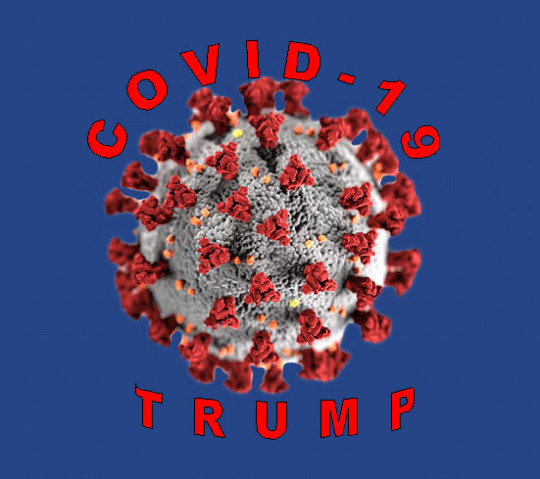
On the sixth of August 1945 in a blinding flash of light about 80,000 poor souls disappeared. On the ninth of August 1945 in another blinding flash of light about 40,000 poor souls disappeared, making a total of about 120,000. Here in the USA we have seen 162,833 poor souls agonize for days, weeks and even months before succumbing to the COVID-19 Virus.

Those left wing, radical Democrats are at it again. They had their Russia hoax. They had their impeachment hoax. Now they are politicizing the virus. The radical, left wingers have their new hoax, the virus. This is their new hoax. But not to worry. There are only a few people infected and many of them have already recovered. We have it completely under control.

During January, February, March and on statements like the following were often heard: “We have it totally under control. We’re going to have a very good ending for it. That I can assure you. When it gets a little warmer, it miraculously goes away. One day it’s like a miracle, it will disappear. Its only a few people and many of them have already fully recovered. It will go away. Just stay calm. It will go away. No, it’s not a pandemic. Not at all. We have it under control. It’s going to be just fine.” We citizens were given only empty assurances - no planning or preparation and no federal action.
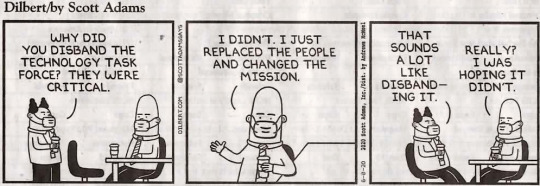
The Obama administration had created a Pandemic Task Force under the National Security Agency to combat the Ebola Crisis which it was successful in controlling and confining to Africa. In 2011 Obama ridiculed Donald at the annual White House Correspondents Dinner. Donald was there, having been invited by Bill O’Reilly. Even before that Donald was at war with Obama (birth certificate ring a bell?) and then this episode intensified that emotion to a fever pitch. Anything attributable to Obama had to be overturned or eliminated. So shortly after taking office the Obama created Pandemic Task Force was disbanded. Also funding to the NIH and CDC was cut. Later funds to the WHO were eliminated and the US announced that it was withdrawing from the WHO. Does it look like the US is preparing for a pandemic? Or even considering public health issues. Is Donald solely focused on political and electoral matters? Especially re-election matters?

Donald continued to downplay the threat and possible effect the virus could have in the US. He compared it to the seasonal influenza. He tweeted “So last year 37,000 Americans died from the common Flu. It averages between 27,000 and 70,000 per year. Nothing is shut down, life & the economy go on. At this moment there are 546 confirmed cases of CoronaVirus, with 22 deaths. Think about that! It will go away, it will disappear. We have it completely under control in this country.” That was the action at the WH while many nations of the World including South Korea were testing, identifying, isolating, tracing, identifying and quarantining. This quick action enabled many countries, including South Korea, to avoid a shutdown of the economy. Donald touts his “early USA entry restrictions.” They were not early enough and were porous and ineffective.

The more the virus spread, the more ridiculous and bizarre the statements and explanations became. “My administration is doing a great job at handing the virus. Stock market starting to look good to me. We pretty much shut it down. We have it totally under control.” While doing essentially nothing. No plan. No preparation. Hospitals were becoming desperate for essential materials and equipment - masks, gowns, ventilators. FEMA had no stockpile. Providers were not identified. Requests, even demands, for invoking the Defense Production Act were dismissed as ridiculous.
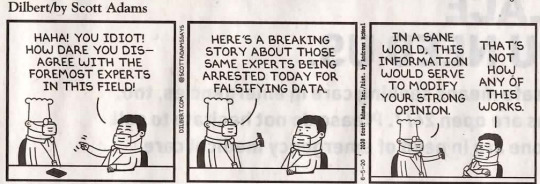
Health experts world wide were stating unequivocally that masks, social distancing and hand hygiene are absolutely necessary to control the virus. South Korea and others continued with testing, identifying, isolating, tracing, identifying and quarantining. Donald refused to wear a mask and refused to advocate the essentials for controlling the virus. Some indicated that he thought wearing a mask made him look weak. Is his vanity more important than people’s lives?

When Donald finally acknowledged that the virus was a problem, he stated something like ‘no one could have imagined something like this.’ That’s Trump-Speak. I’ll translate for you. “I didn’t imagine something like this.” There have been pandemics ever since we humans began to domesticate animals and they occur ever so often. It is not a question of ‘if,’ but of when is the next one? Innumerable books have been written about the subject and many, many movies have been made about the subject. Donald’s statement illuminates his level of education and knowledge.

The base was following Donald’s lead in social media, posting ridiculous and harmful information right and left. As well they were following Donald’s lead in ridiculing the three essentials. Donald, apparently in desperation to stop the virus, send people back to work, restore the economy and get himself reelected; suggested that the drug hydorxychloroquine could be a “game changer” in treating the virus. It was and is well known that this drug is ineffective in treating viral diseases and could be deadly. It is used in the treatments of malaria and lupus. FDA, NIH, CDC and all other medical authorities emphasize that the drug should be used only under a doctor’s care, in a hospital setting or clinical trial. The drug can be dangerous otherwise. In fact deadly. Is hydroxy our plan for controlling and treating the virus?
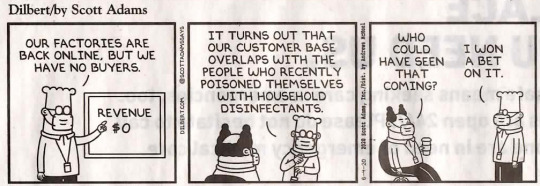
Yes, it is absolutely true that Donald mused that household disinfectants could be taken in some way or injected to cure the virus. Lysol and other providers of household disinfectants immediately warned the public against injecting their product in any way. He continued his statements about hydroxychloroquine. A couple in Arizona who had a derivative of the drug on hand, took it and both were hospitalized. The husband died. For years it has been used to treat malaria and lupus under a doctor’s direction. The FDA and all medical associations clearly state that the drug should be used only under a doctor’s control, in a hospital setting or clinical trial. Nonetheless, Donald continues to advocate for the drug. Remember the 5 September 2019 Hurricane forecast? Donald had said that Hurricane Dorian posed a threat to Alabama. The NHC said it posed no threat to Alabama and showed that it did not on its map. Donald then showed an NHC map where a black marker had been used to extend the map into Alabama. Donald could not admit that he had erred in saying it posed a threat to Alabama. His ego would not permit it. Could that same ego be compelling him to admit that he is wrong about hydroxy, as he now calls it in August 2020. The full name of the drug is a bit much for Donald to be continually pronouncing.

Even with millions infected and thousands dead, the bizarre, untrue, confusing, often contradictory statements continued to be disseminated. Regarding hydroxy: “it seems to have an impact, front line workers and doctors use it, a lot of them are taking it as a preventative.” The Tea Party organized a conspiracy touting doctor and people in white coats in front of the Supreme Court to tout hydroxy. Donald was ready to tweet and re-tween this video. He played it on a news conference There is absolutely no scientific evidence to support an endorsement of this drug for the treatment of this virus. The suggestion that it prevents infection is ludicrous and harmful. That colossal ego won’t allow any admission of error or even the hint of it. Quite a few respected people had short tenures in this administration because they would not kiss the ring and pledge unequivocal loyalty: James Comey, Andrew McCabe, Rex Tillerson, HR McMaster, John Kelly, James Mattis, Kirstjen Nielsen, Rod Rosenstein, and John Bolton are among those on the list. Donald got rid of these respected people who have integrity, morality and honesty. Trump kept fishing until he found people who would kiss the ring and pledge loyalty. He now has Mike Pompeo as Secretary of State and Bill Barr as Attorney General. This is serious business, deadly business; but one can’t hide a smile when Mike Pence prefaces his Donald remarks on anything with something like “the nation thanks you, Mr. President, for your great leadership.”
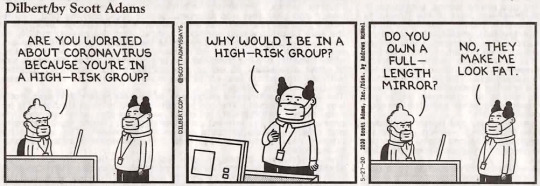
People across the US, but especially among Donald’s supporters, were not taking the virus seriously and adhering to the three essentials: masks, social distancing and hand hygiene. The casualties continued to mount without central leadership. Now, here in August 2020 while being fed ridiculous and bizarre information without central leadership and planning the casualties continued to mount. We have already passed the number of US Military deaths in WWI and are forecast to approach the number lost in WWII. We have already suffered more deaths to COVID than we did in the Vietnam War, the Korean War, the Iraqi War, the Afghanistan War and the Revolutionary War combined. Still there doesn’t appear to be a central plan for the nation to combat, control and defeat the virus. Each governor, each mayor seems to be on his or her own. It appears that most of the Republican governors are following Donald’s lead with no shutdown, no support of the three essentials.
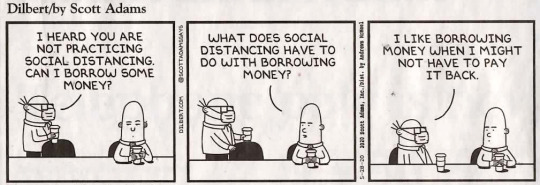
Donald has refused throughout the year to advocate for the three elements that are well known and proven to save lives. Masks, social distancing and hand hygiene. The millions of people who support and follow Donald with no reservation are in severe and predictable danger. With no firm and decisive leadership to combat the virus, it was left to the governors and mayors to combat the epidemic. They were often competing with each other and even with FEMA for critical supplies. It was a situation of total chaos. There is no other description for it. With over a thousand people a day dying, reelection seemed to be the focus of the national leadership. Public health and the virus seem to be secondary to political and electoral considerations. Donald continued to refuse to activate the Defense Production Act and designate firms to expedite the manufacture of the critically required medical supples and equipment.

Social distancing, masks, hand hygiene - we must get used to it. That is the necessary path on the personal level. On the national level, we must have a well organized and well documented regime of testing, identifying, isolating, tracing, identifying, quarantining. That is the well known and well documented path. It has worked in the past. It is working now - just not here in the USA.

Even now in August 2020 the only place where testing is adequate in at the White House. You cannot enter the grounds without being tested. Anyone who is scheduled to be near Donald is tested and the result known in 15 minutes. So, Donald disparages the three critical elements while demanding them in his vicinity. He is safe in his biological cocoon. We should be testing, identifying, isolating, tracing, identifying and quarantining. This is the well know path and other nations are proving it is the correct path. We are not doing it and have no plan to implement it. That is why we with only 4 percent of the world population have 22.5 percent of the world COVID fatalities.
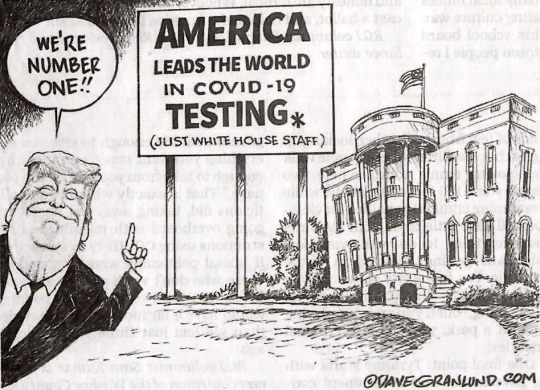
There is probably no place in the world where testing, spacing and hygiene are more prevalent than in the White House. All this while Donald leads us --- I started to say leads us, but that would be completely incorrect. In order to get reelected he is ready to SEND us back to school, back to work, back to invigorating the economy and on to the graveyard while Donald stays safe in his biological cocoon and on his way to reelection in November. He thinks. He hopes. He apparently thinks that a vigorous economy will lead to his reelection. He is thinking only in political and electoral terms. In fact, re-electoral terms. Donald dismisses as absurd the fact that he inherited an expanding economy from Obama. In spite of all Donald’s bragging about generating the economy, it’s actually Obama’s economy, not Donald’s. The GOP senate seems to be getting concerned with dear Donald and his potential impact on their re-election prospects. Remember, Number One on any Washington politician’s agenda is to either get elected or re-elected. Party is second on the agenda. Constituents are on the list, but only at a distant third due to their vote. Whatever is fourth is way, way, way down a distant fourth. You will notice I have not mentioned the nation.

Perhaps the reason there are no masks in the Oval Office is that someone might clandestinely pose the truth, as is shown in the comic. Donald now seems to have surrounded himself with people who have kissed the ring, so there doesn’t seem to be anyone there who would dare such a thing anyway. Donald must be feeling great having everyone who comes into the Oval Office, after having the 15 minute test of course, tell him what a great job he is doing. And thank him for his great leadership.
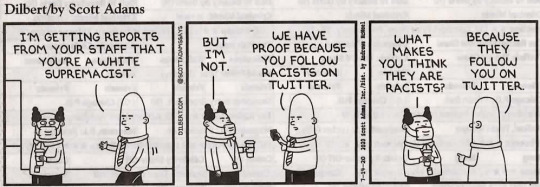
There is ample evidence in video clips, tweets, interviews and actions that supports a belief that white supremacist views and racism are rampant in the organization, especially at the top. He and his dad were well known for housing discrimination and were brought into court over it by federal prosecutors. Donald has a well documented history of speeches, actions and court cases that are widely viewed as racist or racially charged, and his views, statements and actions regarding white supremacy and white nationalism are just as well documented. Donald’s sexual misconduct would fill a book, perhaps several. There was Stormy Daniels, Karen McDougal and the payoffs. He has been accused of rape, sexual harassment, and many levels of misconduct. Over 22 women are on this accusation list.

Anyone who suggests the slightest fault will feel the full wrath of Donald. Comey would not pledge loyalty and suggested that a statement Donald made could have been better. Then he was fired with vengeance, getting the message via TV when Comey was in LA. Trump wanted to cut him loose at that point, but Deputy Director Andrew McCabe gave Comey a ride back to Washington as if he had not been fired. This infuriated Donald, and McCabe was fired one day before his retirement. Secretary of State Tillerson called Donald a moron and was fired on twitter. McMaster called him an idiot and was duly dispatched.
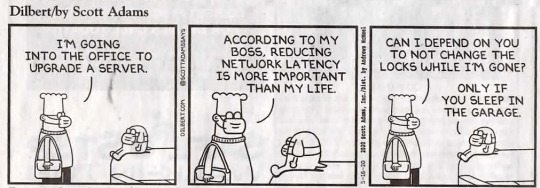
Donald is imploring everyone to get back to work, get the economy going again and thereby with a vibrant economy he will be reelected. The consequences of working in unsafe conditions doesn’t appear to be of any consideration. The meat packing and chicken processing industry unfortunately discovered the hard way what would happen when working in close contact without special COVID safety considerations and precautions. Many families in those industries are in mourning.

With no universal guidelines and/or plan, Donald and Betsy advocate that schools should be opened completely with in-person learning and teaching. They offer no guideline or plan and no money to make the operation as safe as it can be. In fact, they both said that if the schools don’t fully reopen federal money would be withheld. Donald stated that returning to school will be safe because children are virtually immune to the virus. Therefore there is no problem with opening all the schools. As the overall statewide COVID response was left to the governors and mayors to figure out, the school decisions regarding teaching our children is left to the local school boards, administrators and principals.
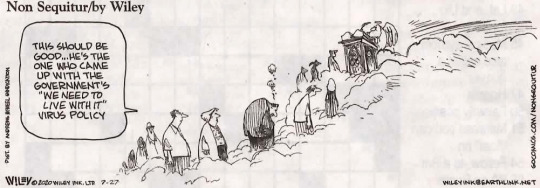
Is that Donald finally social distancing? He says that he takes no responsibility for the chaotic and unorganized response to the pandemic. In fact, with no plan, no action, he had the audacity to say that he had a well thought out and smoothly operating plan in operation. That statement is absolutely ludicrous and ridiculous when state Governors are competing with each other and even FEMA for desperately needed supplies and equipment. There are some Evangelical leaders in this nation that are teaching in their sermons that God chose Donald to be the President of the United States. This was obviously communicated to Donald. In one of his impromptu media events, he pointed to the heavens and said “The anointed one.” From my standpoint, I think Donald was chosen alright, but by the other guy.

The citizens of the US continually receive mixed messages that often are contradictory even to the bizarre level. Fortunately in this comic, dad, mom and the children are staying home, sheltering in place. In other strips they wear masks, social distance and wash hands. At least the comic pages are addressing the nation with consistent war-winning messages. Not so with Donald. He started off his tenure with lies. Remember the largest inauguration crowd in history? Kellyann Conway was funny in trying to explain that one with “alternative facts.” Finally, there were just too many and no one would try to explain them away. He is telling them at a rate of 23.3 per day. He is up to 19,127 in 1,226 days. There is no question that he will top 20,000. Will he top 25,000 on this term? His Press Secretaries are a source of humor. They all have lied. Kayleigh McEnany often gets two or more in one sentence. Much like Donald. I recall one day I was listening watching Jake Tapper on CNN. Donald gave one of his impromptu news biefings as he went to the helicopter. It was about 5 minutes. Jake said that nothing he said was fully truthful and he broke it all down. Donald is a pathological lier. You can’t deny it. The evidence is there. Everyday. He has lied about guns, economy, education, elections, COVIS, crime, Russia, jobs, environment, taxes, foreign policy, health care, immigration, terrorism, trade, Ukraine. Familiar?
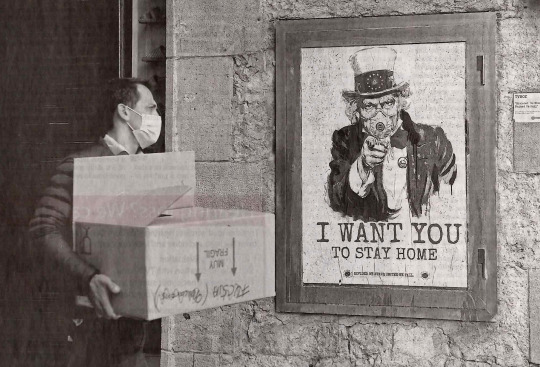
Donald did not want business closures, shelter-in-place, masks, social distancing, and hand hygiene. That sort of action brought the economy to a virtual halt. Donald depends on a robust economy to get reelected. Nothing will stand in his way to advocate for that robust economy. And certainly his rhetoric has been in support of that to the expense of everything else. If the US had been ready, as was South Korea and some other nations, we could have controlled the virus and saved thousands of lives. And it would not have been necessary to shut down our economy. Perhaps we could not have prevented a commensurate number of fatalities because we are such a diverse people, but thousands of lives could have been saved. Even now, on 9 August 2020, Donald is saying that the virus will disappear and that we are doing well in combating and controlling the virus. We lead the world in infections and deaths. We have no winning path to follow. Our response has been a total failure.
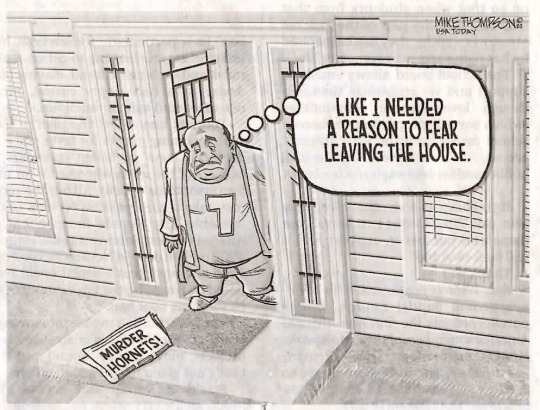
The country sorely needed the commander in chief to come to the Resolute Desk and state unequivocally to the country that this virus is serious, is of pandemic level and all citizens must come to the aid of their country by sheltering in place when possible, vulnerable businesses should close, others that must remain open do so with strict safety precautions, wear masks when in public, strictly social distance when in public, and employ strict hand hygiene. Instead the three essential elements were ridiculed. Nearly every day the citizens were told that the virus would go away, we have it totally under control. All the while hospitals were overflowing, infections and deaths were escalating.
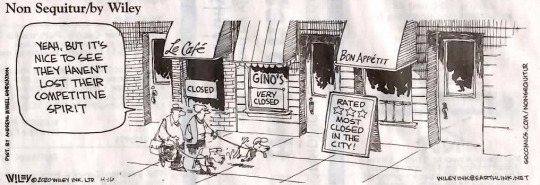
In an effort to stem the spread of the virus, to mitigate infections and deaths, many governors and mayors closed all but essential services. Regrettably not all however, many Republican governors heeded to the clarion call by their leader, keeping everything open and allowing large gatherings to occur without masks or social distancing. However, over much of the country, the economy was coming to a screeching halt. Donald was blaming those governors for not being prepared to control the virus, while not mentioning that it was the federal government’s responsibility to be prepared for a pandemic and that they had eliminated the Obama created Pandemic Response Team. There was no pandemic team, no plan, no leadership. Can you imagine on 7 December 1941, FDR telling Hawaii that they should have been prepared. Probably won’t happen again. We’re here to support you if it does.
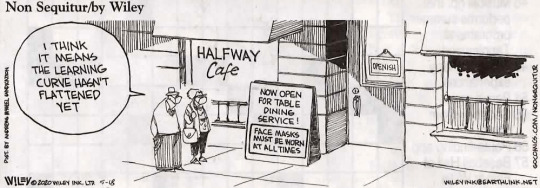
Donald doesn’t talk about saving lives and his national plan to control the virus and save lives because he doesn’t have one. His focus is getting people back to work and getting schools open to aid in getting people back to work. The economy must be restored. Donald needs it to get reelected. Go back to work. Forget that distancing and masks stuff. It’s your personal choice, your personal freedom, your First Amendment rights. Don’t worry. We have a perfectly coordinated and fine tuned plan at the White House for our attack on the China virus.

The colossal eater, Dagwood, is not left wanting with restaurants closed or open only for delivery or take out. It is to be noted that South Korea with a plan in place for a pandemic and a team to execute that plan did not have to close their economy to control the virus. The US and South Korea both had their first COVID death on 20 January 2020. Korea immediately took action. The US did nothing because the US pandemic team had been disbanded and the office closed. The South Korean President Moon Jae-in fully and vocally supported his team, their plan and their action. They even had the top pop group come up with a catchy tune extolling the three essentials. Soon the whole country was humming the tune. The US President ridiculed the virus as little more than the seasonal flu and something that would soon just go away. Then went golfing.

No question about it, extensive solitude can wear on you. One of the most severe penalties in a prison is solitary confinement. In this case, adhering to the three critical elements is a life-and-death matter, especially among the older population. The immune system decreases in effectiveness with older age. Therefore, mom and dad, grandma and grandpa should be considered to be in the extreme, high-risk category. This is really a life-and-death situation for them. Young people who do not adhere to the three critical elements can take the virus home to them. Remember, 40% of cases are asymptomatic.

Distressing news abounds regarding the chaotic, disorganized response to COVID - 19. And the resulting consequences are the most distressing aspect. Medical and economic lead the way, but there’s more. Regrettably we have other news that is less distressing, but distressing nonetheless - severe, chaotic, unseasonable weather - stronger storms, more tornadoes, bigger hurricanes caused by global worming - another hoax according to Donald. Wildfires in the West are more intense and now occur all the year, not just in the Autumn ‘fire season.’ That is caused by incompetent forest management, not the drought enhancing global warming, according to Donald.
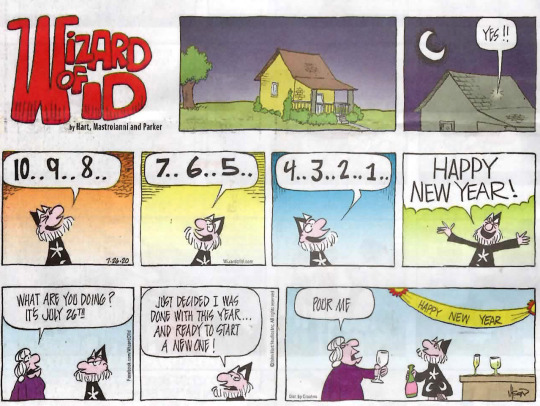
Don’t we all wish we could start over in January and that COVID would not be present? Unfortunately, here we are with millions of people infected, many with weird consequences after recovering, and over 162,833 dead. Donald continues to state that he doesn’t think he has any responsibility for the infections and deaths. In that regard he recently stated that it is what it is. Do you hear any acceptance of responsibility or remorse?

Sheltering in place, solitude, cabin fever - it affects all of us, even the children with their nearly limitless imagination.

Yes, anxiety and more serious consequences are a real possibility for everyone in this situation. Many people are worried about COVID and its most serious consequences and are also worried about where the next meal is coming from and that rent or mortgage payment. A large portion of the country’s work force is living pay check to pay check. This was obvious when Donald stopped the government in December 2018 because the congress would not provide funding for his beloved border wall. Immediately there were long lines at the local food bank. Donald indicated that they were mostly Democrats anyway. Do you see concern and compassion? (The US Supreme Court recently agreed that Donald could divert funds that congress had designated for military projects to fund the WH border wall. I’m no constitutional scholar, but doesn’t that decision violate the constitution - balance of power, checks and balances? Is the Supreme Court now only a political extension of the GOP?)

Where does the nation find some hope, that there are better days ahead? Who’s to tell us that the storm is intense now with seemingly dark skies in every direction; but if we can all work together there near the horizon is a break in the clouds with blue skies, rainbows and calm seas in the distance? Let’s work together to get there. And tell us that in a convincing and believable manner? Who is the leader that can do that in a convincing and believable manner? Do we have one?

This is war. Casualties are high. We have lost more people in this war than in nine of the wars this country has fought. This time our warriors on the front lines battling the enemy are not our US Military; but rather are first health care people and then are people scattered across the economic landscape. They are your family members and neighbors.
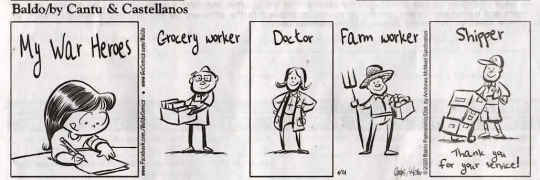
Yes, these are some of our war time heroes in this battle. The front line is in the hospital, in the market, even in the street - and making it more difficult the enemy is armed with invisible bullets which remain lethal even when they are just laying around on any surface.

These heroes are not looking for medals. They are just looking to stay alive while doing their war-time, peace-time essential work - and by doing so help the rest of us to stay alive, too. We must do our part, too. It is essential that we strictly adhere to the three essential actions: wear a mask, social distance, hand hygiene. It is not rocket science. It is common sense. These actions will save lives and will defeat the enemy. There is no other way to save lives and win this war. A vaccine is far in the future.

Mother’s day has come and gone. Sadly many of our moms have also come and gone due to this virus. The immune system decreases in its effectiveness with age. In addition, older people often have other ailments, too. Therefore, older people are very vulnerable to this COVID - 19. The older you are, the more vulnerable you are. Regrettably the numbers and the statistics reflect this as the current reality. Grandma and grandpa are in the extreme, high-risk category. Don’t bring the virus home to them. Adhere to the three essential elements. Again, remember that 40% of cases are asymptomatic.

Thankfully, cartoonists and comics can usually find a bit of humor in the direst of circumstances. With millions of people infected and thousands dead, it is difficult to find a smile anywhere in this dilemma. But, yes, early on we were scrambling around for toilet paper. Then we were desperately scrambling around for medical resources and equipment. Hospitals, cities, states were competing with each other and with FEMA for desperately needed medical resources. We’re number one, aren’t we? Why didn’t we have all of this material that we needed? The Obama created Pandemic Task Force had been disbanded and the office closed by the current administration. Funds to the NIH and the CDC were also cut. Payments to the World Health Organization were withdrawn and the US withdrew participation in the WHO. The severity and the potential of the virus was continually down-played, even until now with millions infected and thousands dead. Planning and action was left to the governors and mayors. Even procuring the desperately needed medical equipment was left to the governors and mayors. When the federal government finally stepped in to procure equipment the task was given to a Harvard economist and a real estate broker. The effect was continued chaos as thousands died and the nation scrambled for needed medical equipment. If a manager gives a critical task to an incompetent person, that means that the manager is incompetent. Donald continues to assert that he is not responsible.

The economic forecast is indeed bleak at this point. Millions of people are out of work and anxious that the job will still be there when the return to work is possible. Owners are just as anxious that they will be able to survive when it is possible to reopen. People are afraid to fly, afraid to eat out, afraid to enter the retailer. The importance of the intervention taken by the congress cannot be stressed enough, not only in surviving; but of emerging from the crisis, also. Unfortunately, it appears that the US does not have the leadership, organization, planning and discipline to recover and avoid a recession.
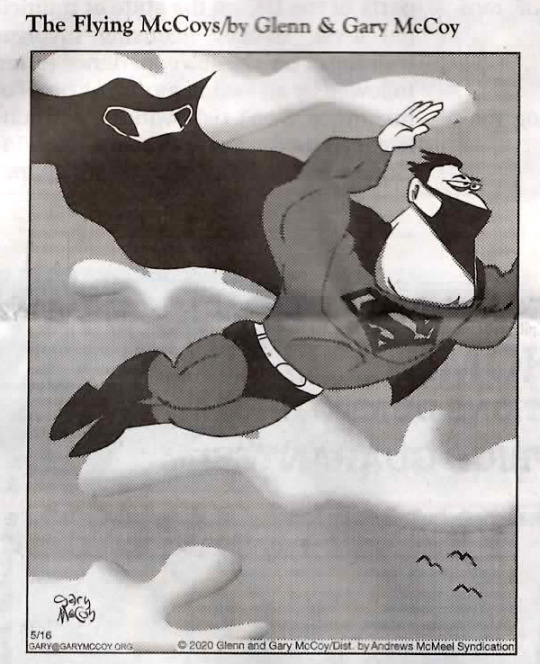
We desperately need a hero to step in to lead us out of this mess. We have someone in that position. Here’s an evaluation of him by people who have worked with and/or for him:
Comey - flawed unethical immoral ego-driven, Pruitt - an empty vessel, Tillerson - moron, McMaster - idiot, Cohn - an idiot surrounded by clowns, Corker - adult day care, McCain - sad and half-baked, Bannon - he’s like an 11 year old child, Graham (before nomination) - race-bating xenophobic bigot, McConnell (before nomination) - unfit to serve.
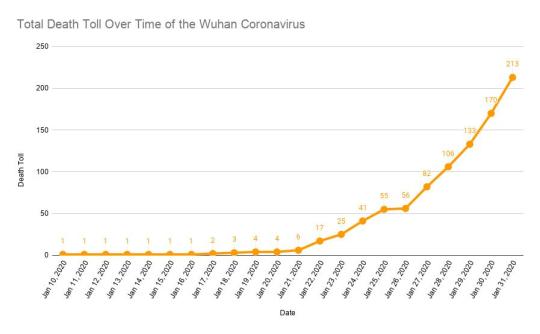
This was the period where we could have made a big difference with testing, identification, isolation, tracing, identification and quarantining. South Korea was busy doing just that during that time. What were we doing? We were suffering and dying. Our leader was playing golf.
It is said that a picture is worth a thousand words. The graph below is an indication of our situation in the USA today, 9 August 2020.
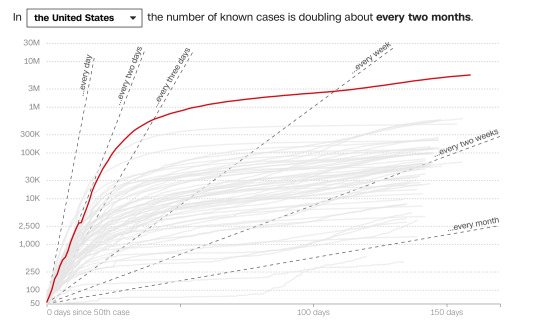
How do you think we are doing? With 4% of the world’s population we have 25% of the world’s infections and 22% of the world’s fatalities. Here in August 2020 Donald has said that we have a perfectly coordinated and fine tuned plan at the White House for our attack on the China virus. Sounds good. Do you believe it?
We have mentioned South Korea several times in this document. The graph below indicates their situation, their progress.
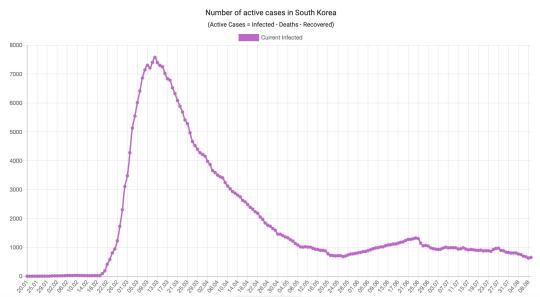
If the US had acted as South Korea did, what would the result have been? Let’s prorate the two countries. The population of South Korea is 51.61 million. The population of the USA is 331 million. Therefore, the US has 6.4 times as many people as South Korea. Korea has suffered 14,598 infections and 305 deaths. Therefore 6.4 times 14,598 equals 93,427. And 6.4 times 305 equals 1952. Therefore, if the US had done as well as South Korea in combatting and controlling the virus we would have had 93,427 infections, not over 5 million. And we would have had 1952 fatalities, not 162,833. And we would not have had to shut down our economy, just as South Korea did not have to. Our NIH and CDC is the envy of the world. Therefore, who is responsible for the 160,881 deaths we suffered but could have saved if we had done as well as South Korea in controlling this virus? And who is responsible for our having to shut down our economy?Any ideas?

0 notes
Text
Graphic novel on the Tiananmen Massacre shows medium’s power to capture history
As a young man in Beijing in the 1980s, Lun Zhang felt like he was taking part in a new Chinese enlightenment.
The country was undergoing paramount leader Deng Xiaoping’s “Reform and Opening Up,” and previously sealed-off areas of knowledge, arts, and culture were becoming newly available.
People who had only years before been living in the stifling, hyper-Maoist orthodoxy of the Cultural Revolution, in which anything foreign or historical was deemed counter-revolutionary, could now listen to Wham!, hold intellectual salons in which people read Jean-Paul Sartre or Sigmund Freud, or even publish their own works, taking aim at previously sacred political targets.
“In those days, our thirst to read, learn and explore the outside world was insatiable,” Zhang writes in his new graphic novel, “Tiananmen 1989: Our Shattered Hopes.”
But with this intellectual awakening came a growing frustration with the pace of reform in China, particularly how economic liberalization was taking precedence over any suggestion that the Communist Party give up its tight control on the country’s politics.
An apocryphal quote attributed to Deng captured the mood at this time, that “to get rich is glorious,” but for many people, it was increasingly apparent that only a handful were becoming wealthy, while others were suffering due to growing corruption and the destruction of the social safety net.
Small demonstrations against graft and for greater political reform ballooned into what would become the 1989 Tiananmen movement, in which hundreds of thousands of people protested across the country, with the largest demonstration in Beijing led by workers and student groups.
The pro-democracy protesters occupied Tiananmen Square for months, even holding meetings with top officials. At the time, many felt hopeful that these actions would bring about wider societal change in the one-party state.
Crackdown
Zhang was on the square that spring, when the protesters put forward seven demands, including for democratic elections and an end to state censorship. He was there as the crowds paid tribute to the late reformist leader Hu Yaobang, and he was there as the occupiers sang and danced on what had become the people’s square.
He was not there when soldiers opened fire on protesters and fought with them in the streets of the Chinese capital. He was not there when the tanks rolled in. Zhang was in the suburbs of the city with another activist, recuperating in preparation for what some thought would be a last push before the government gave into the protesters’ demands.
“When we heard the army had entered Beijing, we tried to reach the square, but our efforts were in vain,” Zhang writes of when they learned of the bloodshed.
Far from reaching the center of the city, Zhang’s attention turned to escape: the authorities were rounding up prominent protesters and leaders, and he was worried about arrest. He fled first to rural China, eventually becoming one of dozens of Tiananmen protesters smuggled into Hong Kong by activists in the then British colony.

An excerpt from “Tiananmen 1989: Our Shattered Hopes.” Zhang (pictured wearing a sash on the bottom left) was a young sociology teacher in the late 1980s. During protests, he was in charge of management and safety. Credit: IDW Publishing
Graphic novel
Zhang eventually moved to France, where he has lived ever since, and is teaching at the Cergy-Pontoise University near Paris. While he writes about the Chinese economy and geopolitics, he has largely left out his own personal history prior to this month’s publication of his graphic novel.
“I worked with (French journalist) Adrien Gombeaud, who wrote the script for the format,” Zhang told CNN. “We read some graphic novels about historical events, and together came up with the plan, for example, to imagine a theater scene to link all the parts of the story.”
While the Tiananmen Square Massacre has been widely covered in the media and in documentaries, with many focusing on the iconic image of the Tank Man or utilizing archive footage from the square itself, much of the events leading up to the infamous night have been lost to history, available only through witnesses’ accounts. Zhang said that the comics format provided a key means of capturing the emotion of the demonstrations, in a way that does not necessarily come across in text.
“It is difficult to find a satisfactory way in which this kind of big event is reported, in my opinion,” he said. “In some reporting on Tiananmen, the authors didn’t reflect enough on the will of students to cooperate with the authorities in peacefully reforming China.
“When you take into account the emotion involved, we can understand why the peaceful way of demonstration was chosen, why there was the huge hunger strike.”
After the initial script was written, the authors worked with French artist Ameziane to develop the comic’s visuals, by sourcing images of the various characters, and referencing archival photos of era-appropriate objects, such as clothes, cars and teacups from 1980s China. “We spent a lot of time in discussions on how to arrange the scenes, how to convey the essential message, what limits we might have on a given page. It played to the style and skill of our painter,” Zhang said.
The shift in artistic style is most notable in the scenes depicting the massacre itself. Prior pages feature white backgrounds and muted colors, but as the crackdown begins, the pages turn to black, with a heavy use of oranges and reds. Ameziane’s illustrations become looser and full of movement, emphasizing the chaos and panic experienced by the characters.
The book is structured in several acts, with Zhang as its narrator. He said the play format was an obvious storytelling device, given “the protest movement itself felt like a drama, with its different phases akin to great acts.”
Comics journalism
Zhang, Gombeaud and Ameziane’s book joins what has quietly become a major strand of modern comics: graphic journalism or historical comics dealing with topics that were once considered out of the art form’s remit.
American cartoonist Art Spiegelman’s “Maus,” a Pulitzer Prize-winning account of his parents’ experiences as Holocaust survivors — with the Jews depicted as mice and the Nazis as cats — has long been considered a masterwork in the graphic novel genre.
While adult themes and history were features in comics long before “Maus” debuted in 1980, including in Spiegelman’s own work, its use of accessible, black and white art combined with a sweeping historical narrative broke into the mainstream, and set a new standard for “grown up” comics with political subject matter and potentially upsetting content.
Works like Maltese-American Joe Sacco’s ground-breaking comics journalism in “Palestine” or “Safe Area Gorazde,” and French-Iranian Marjane Satrapi’s “Persepolis” have further driven this trend, with the latter turned into an Oscar-nominated movie in 2007.
The popularity of comics and graphic novels has only grown in recent years — with the help of blockbuster film adaptations. This has happened in conjunction with the rise of comics journalism, in everything from newspapers to dedicated publications such as The Nib, which has long recognized the medium’s ability to tackle serious issues, interweaving reporting with satirical cartoons.
Sacco has talked about how the use of comics, the presentation of the artist and writer as a figure in the story, helps remove “the illusion that a journalist is a fly on the wall, all seeing and all knowing.”
“To me, drawing myself signals to the reader that I’m a filter between the information, the people and them. They know that I’m a presence, and that they’re seeing things through my eyes,” he said in a recent interview.
This is very much apparent in Zhang’s book, as he uses his role as narrator to critique both the protest movement and himself.

“Tiananmen 1989: Our Shattered Hopes” cover. Credit: IDW Publishing
Asked once about whether drawing helped him deal with being the child of Holocaust survivors, Spiegelman answered: “I’ve had therapy, and I’ve made comics. The comics are cheaper.”
Part of “Maus” deals with Spiegelman’s guilt over his difficult relationship with his father and in comparing his problems with depression and work to the experiences of his parents. Zhang too writes in “Tiananmen” of his own survivor’s guilt and of questioning his decisions made as a younger man in the midst of history.
In an interview, Zhang said he did not write about Tiananmen for so long, because his role, his involvement, seemed inconsequential compared to what some went through.
“The way I saw it, there were many people dead or wounded in the aftermath, and many people lost their jobs; their families were never the same after,” he said. “The real heroes were the ordinary students and people in (Beijing) and other cities. By comparison, what I did personally didn’t seem worth telling. The most important thing I could do was live my life in a way that wouldn’t dishonor the dead.”
He was eventually convinced by an editor to write the book last year, around the 30th anniversary of the massacre. “She convinced me that I had a duty to the memory of that time,” Zhang said. “I accepted it. ‘No justice, no peace,’ but I think also, ‘No memory, no justice.'”
“Tiananmen 1989: Our Shattered Hopes,” published by IDW Publishing, is out now.
Source link
قالب وردپرس
from World Wide News https://ift.tt/3hPkAA7
0 notes
Text
My thoughts on Magi’s finale
Let’s start with: My disappointment was SOOOOOO great at the beginning, middle and a little before the end of this disaster of an arc, that this is just a joke to me tbh.
In my opinion this arc was so bad, that the ending doesn’t feel as bad. Its worst part at most is how underwhelming and incomplete it is. But there’s a positive thing in it being so open: it feels the story continues. Tbh I don’t feel this is the end. I hope we get more content somehow and if not, I don’t mind it.
Its strongest point is that it didn’t feel like the cliche ending all shounen manga have (even tho I’m a fan of shounen manga cliches, their endings tend to suck). This ending only had one cliche which was alimo r’s wedding, which didn’t even had much focus than Mor’s outfit. But ofc cliches can be good and even amazing when an author gets the best of them...... this was not the case of course.
The problem with Magi overall, in my opinion, is that it tried to be too creative, too revolutionary for a shounen manga, some cliches were avoided on purpose, sometimes with great outcomes but most of the time what we got in return was not better than cliches. That’s the problem. When you offer something new you have to make sure it’s better than what has been done before, not just different. And this why I think Magi’s popularity started to go down (well to be fair it happened during Alma Torran, and it continued on Kou arc). Then, probably the editors decided it was time to put some shounen manga cliches, to appeal to the boys at least. Cliches like the excesive use of Alibaba as THE ONE and only who solves all problems and who never gives up with a big smile!!!!!!!!! And using only the young king vessels and magi to fight the final boss (Sin), cause they are the cool ones and more appealing to a male young audience than older adults and women. Also the battle tried to be epic but faced the problem of everyone being too overpowered to fight with physical or magic strength. Thus it became a battle of words... which was weird, because these four boys didn’t know or understood Sinbad as much as his family did and they also weren’t the ones who would normally wish Sinbad to change his mind the most. But the boys were cool and could appeal the typical shounen manga audience, also they were powerful, so Sinbad’s people were thrown aside....and it felt weird. Suddenly the creative and different ways of Magi started to adopt very bad shounen manga cliches and tropes, like what happened with Nerva. At least I felt it didn’t belong to what has been done before. Especially since to Aladdin, Alibaba became the ultimate king (I thought Aladdin would also realize there’s no ultimate king at some point) and also every character, Sinbad included, fell for his words, even tho Mogamett stated that nothing can’t be left to a single being. Ofc we heard everyone’s opinions about what to do in the end, thus it was not Alibaba alone. But it still felt that Alibaba was THE ONE and only one who fixed it all, instead of it leaving us the feeling it was everyone’s power united. A few panels of characters we never get to see on a normal basis are not enough to give the feeling everyone helped. Their apprearances felt meaningless and piled up there, so that no one dared to say it was Alibaba alone. But we all know the one who made most was Alibaba and not everyone as a team, thus the premise of last arc which was Mogamett’s warning fell apart for completely. Which sucks, because Magi was about no one being always right or always wrong, but now there’s Alibaba. People love to criticize other people for focusing on their ships only. But see, I loved Magi, all Magi, Magi overall. But Alibaba felt annoying at the end. All over the place, everyone adoring him, all focus on him. All interactions happened with him, he even has a panel with Titus lol. Aladdin lost the title of main character. He got some really cool moments, but not as much as a main character does and definitely not as cool as he did in previous arcs. Ever since Alibaba died, Morgiana’s potential was focused on loving Alibaba only. She also had great moments like her battle with Arba, but then she just stood next to Alibaba in silent, like a bodyguard, while her other interactions included: having quarrels with Alibaba and serving him food, and the worst: becoming damsell in distress (it’s my opinion). My babies, my main trio got destroyed for me. What’s next on the list: Sindria. Everyone scattered, I had the joy of them being happy in separated places but since Sin and Ja’far didn’t seem to be fine I was worried. Then Sinbad said awful things about his family, even tho the chapter before he claimed it was all for protecting them...yikes. And everything started to fall apart. This arc was focusing on Sinbad destroying the relationships he has been protecting all his life and that made him who he was. Those were my absolute favorite relationships, btw. Moreover he was throwing away people who have always loved him and been loyal to him. All of those beautiful relationships, gone...... I could go on: the pace: went crazy, climaxes all over the place, underwhelming endings subplots: murdered, slaughtered and new ones being born to be interrupted right away. character development: Alibaba and Hakuryuu the only champs. Everyone else’s character development happened off screen or didn’t happen or was left interrupted. Many questions unanswered, unrealistic ideal ending when Magi used to be resemble our world, at least politically speaking. Etc, etc.
And after all this becoming bad, what else did I have? My ship ofc, that’s the only thing I had left, because everything else I loved was ruined. So, sorry for focusing on my ship but everything else sucked to me, which makes me sad, but it’s the truth.
Thankfully my ship isn’t as destroyed as it could have been (well it had been destroyed since the beginning of this arc, but it could have been worse) thus I’m not as mad and angry. I’d rather have Ohtaka hint Sin is coming back and Ja’far saying with exact works that he’s sure he’s coming back someday, hence he will wait, ....than nothing. And I’ll grab that small moment and move on and continue to have fun with my ship and my friends and continue to be happy.
This arc for me sucked, but that doesn’t mean I’m still over Magi. I still love Magi so much.
To sum up, the ending was not the worst of this to me, that’s maybe why I think I don’t mind this small last disappointment compared to my great suffering when this started, .......which btw was almost 2 years ago.
At this point I only hope Ohtaka is satisfied with it. And if she is, I’m happy for her cause she worked very hard, so damn hard. But my gut tells me editors limited her several times, especially during this arc .......thus Idk how to feel. I hope I’m wrong. But still the writing’s quality is so low I’d also rather think it was them and not her. Anyway, we will probably never know.
I’m sorry for this incredibly long rant, but I had to get it of my chest. Also expect a positive comment later. Thanks for reading me and I’m happy to say: we all survived this mess! Let’s go party, we all deserve it. Hope Ohtaka is finally chilling too!!
25 notes
·
View notes
Text
Rebel, Saimdang, and the romanticization of class and nobility in sageuks
At this point, it’s actually a little sad that Saimdang: Light’s Diary and Rebel: Thief Who Stole the People are airing at the same time. Mind you, it’s not because one is easily one of the most hyped sageuks in years and isn’t performing well, while the other seems to have just been thrown out there as an afterthought and is pulling in good ratings, as well as better critical and popular response, it’s the content and themes. Personally speaking, I spent almost 2 years impatiently waiting for Saimdang, and was pretty sure it was going to be the best sageuk of the year when it did come out, something that I thought would hold true after watching the first two episodes. In contrast, Rebel was barely on my radar, and on my “watch now” list instead of “watch if people say good things while it airs” primarily because I liked Hwang Jin-Young’s previous sageuk (and only previous writing credit aside from a special) King’s Daughter Soo Baek Hyang. Halfway through their runs,Saimdang was moved to “I really like it but it could be better” status (with a lot of anger for how SBS execs screwed the show and LYA over, and now they’re taking their screwups out on the show, but I’m not going to dwell on that today) while Rebel has become the sageuk I just can’t see another sageuk surpassing it for a while. (Particularly since they all seem to at least partly center around the tropes and worldview that Rebel critiques.)
This requires some background. Saimdang and Dae Jang Geum, aka, one of the most iconic sageuks ever that also served to help solidify Lee Young Ae’s iconic status, take place at roughly the same time. This is something SBS is very aware of, and while it doesn’t have the endless DJG references we probably would have had if the show had aired on MBC, it very much tried t rely on DJG nostalgia to sell the show, and the sageuk plotline in Saimdang has much more in common with sageuks of a dozen years ago in terms of characterization, tone and pacing than anything from this decade. Unfortunately, people came for Lee Young Ae in a sageuk from this decade, not the first half of the last decade.
Now the ACTUAL background begins DJG is largely known in western fandom for helping in to make sageuks far more female-centric, and for helping to establish the basic formula that most of the popular and/or commercially successful “long and stuffy” sageuks have sageuks have followed since. The rest of this is partially hearsay, as I’m going by what others have told me about pre-DJG sageuks, as DJF is the second oldest I’ve seen. The oldest is Damo, a show that is less iconic than DJG, and that essentially created the formula for the genre that we consider to be fusion sageuks. (Depending on who you ask, DJG and it’s predecessor, Heo Joon, are also fusion sageuks, but they’re an entirely different kind of fusion sageuks and Damo and its successors.) Like DJG, Damo centered around a female lead in a plot that would typically feature a male lead. Both shows are also known for taking the focus away from the throneroom. DJG is still a palace intrigue drama, while Damo steps away from the palace completely, focusing instead on police officers investigating a rebellion, though it does check in with the palace intrigue. But in stepping away from the throneroom and inner palace intrigues, both did something most sageuks avoided: they tackled the issue of class. Both shows featured a heroine of noble birth-Chae Ok, the heroine of Damo was a young noblewoman who became a slave as a child after her father was accused of treason, while Jang Geum’s parents both went into hiding as commoners before she was born, though for different reasons. From what I’ve been told, prior to these two, the main audience for sageuks was middle aged men, and because of this, the focus was almost exclusively on war and palace politics, usually featuring, well, middleaged men. Then, in 2003, there was suddenly a spurt of several successful series featuring female leads. They certainly weren’t the first to do so, it just worked out so that there was a concentration of several at once. Part of what made DJG and Damo stand out was that they were meant to appeal to a wider audience, had higher production values, sweeping (and very different) romances, and broader plots (I mean it wasn’t JUST “maybe our ratings will go up if we try to appeal to women,” but that was certainly a part of it). But they also stood out because the positioning of their heroines-one being made a slave and the other growing up as a commoner-meant that these stories weren’t only about the nobility. The servant class in the city featured heavily in DJG, while rural commoners and their perspective of civil unrest and the nobility featured heavily in Damo. Of course, ultimately, both heroines and their love interests WERE of the nobility, but the door to including the perspectives of other classes was open, and most sageuks since then have taken advantage of that door being open.
Many (I want to say “most” but it kind of hovers in middle ground, I think) will have the protagonist spend part of their life as either a commoner or a poor noble. The protagonist of noble birth who lives as a commoner comes in 2 main varieties: they were born in secret in one way or another, and only find out they have noble (or royal) blood much later in life, after establishing themselves one way or another, or they live as a noble or royal as a child, but are forced to live as commoners or slaves for many of their formative ears before reclaiming their true status. On a similar note, protagonists who actually are commoners with no noble or royal blood are considered exceptional. They’re special, they’re…NOT LIKE OTHER COMMONERS. But there’s also the flipside. The flipside is that all the corrupt and scheming politicians, the cruel masters are treated as individuals. Their social status may have contributed to their corruption an cruelty, but only in that the individual would have been that way anyway, they just happen to have more power, and they re many good and kind masters, and well meaning politicians, That the class system itself was a problem, that there was a social order that told people they were inherently better than others by birth, was not a consideration.
Shows have tackled this mindset over the years (Maids and Chuno come to mind for sageuks I’ve seen that try to push the standard approach, re: class, a bit), but none have fully committed to taking it on until now. Except that Saimdang is not the show that did so. Saimdang takes the same approach as it’s predecessor-and most sageuks in between-of romanticizing the nobility while also tackling the plights of the lower classes. But what was revolutionary 14 years ago is not revolutionary now. And then we have Rebel. One of the very first things Rebel does is completely obliterate any idea that Gil Dong has noble blood, in a flashforward at the beginning where King Yeonsangun confronts Gil Dong.
Yeonsangun: “I will ask you clearly. Answer me honestly. I heard you are a descendant of the demolished royal family of Goryeo. Is that right? I heard your anger comes from having a father of the noble class and a mother who is a maid. Is this correct? Then what is it? Who on earth are you?” (Gil Dong is shaking his head in amused contempt throughout this.)
Gil Dong: “I am not a descendant of the royal family from Goryeo. Nor am I a son of a minister, or from a poor noble family. I am only a son of my father. My father, a servant over generations, Amogae.”
Yeonsangun: *outraged, disbelieving laughter* “That’s impossible. It’s impossible that someone like you could’ve been born to such a lowly man.”
Gil Dong: “You were born to the master of this country. How did you turn out to be such a lowly man?”
Ok, first of all, THE BURN THERE, GIL DONG! THE BURN. I can only assume that the camera pans out and away so fast after that so that we don’t see Yeonsangun burst into flames from that one.
HOWEVER, while we didn’t know it when the episode aired 3 months ago, this scene is essential to the world view of Rebel. Because ever “noble” sageuk origin was just shot down, and the idea of the “special” commoner isn’t far behind it. And Yeonsangun NEEDS Gil Dong to have that origin. His worldview cannot allow for a “common” person to have more sway than him. Gil Dong doesn’t simply violate his person worldview, his very existence violates the established social order and divine superiority of birth, something that we come to full force for Yeonsangun at the beginning of the latest episode, and something that is beginning to consume him.
Of course, Rebel relies in part of a prophecy of a “mighty child” (Gil Dong) a child born with superhuman strength and healing powers, destined both to become a general and to suffer great losses if he does not control himself. However, it is not Gil Dong’s power that makes him special, it what he does with it. Gil Dong’s power is not what makes him special or what makes him a hero, but it is part of what makes him able to DO something. The “Mighty Child” is born of necessity, not because some random kid won the genetic lottery. (The “Mighty Child” status is also considered to be a curse, not a blessing.) We’re also given a second mighty Child as a counterbalance, and the second mighty child-of equally low birth and with possibly an even more tragic background-flounders because he can’t even manage to properly misuse his powers, much less achieve the Mighty Child’s destiny. I’ve said plenty about my feelings re: The Mighty Child(ren) in previous tumblr posts and will probably make even more posts focused on that aspect in the future, so I won’t dwell on that now.
Moving on from The Mighty Child: Rebel takes the stance that the class system isn’t simply a case of advantage and disadvantage with good ad bad people, but rather, the class system itself is an ideology, and that ideology is the enemy. It isn’t that there are bad apples (and remember, the point of the whole “bad apple” thing is that if there’s a bad apple among your apples, you need to just toss them all and get new apples, not that you just take out the one bad apple and assume all the others that came from the same place are perfect just because you can’t see their problems on the outside) it is that there cannot be good and there is no justice in a system that holds that one group of people is inherently superior to another, and you cannot expect the people who benefit from that system to help find justice in it. When Gil Dong’s father, Amogae, kills his master, Lord Jo to avenge his murdered wife, the widowed Lady Jo only hates Amogae in part because of her murdered husband. What she truly hates Amogae for, the reason she wants him destroyed, the crime she can never forgive, is that Amogae is an abomination that has violated the natural order.
THAT is the true villain of Rebel. The class system itself, the social order that tells one person that they are inherently superior to another by birth, that the higher your class is, the more the world exists to serve you, is the villain, and Lady Jo, her allies, and Yeonsangun are the manifestations of a corrupt and unjust system. This is something that we and the characters grow slowly more and more aware of, until it’s brutally driven home in episodes 21 and 22, and all illusions and any semblance of romanticizing nobility or royalty are ripped away and ruthlessly destroyed in the most devastating fashion. (Not to mention graphically violent, particularly for network TV standards.) Hwajung touched on this idea a bit with it’s ultimate assessment that it is impossible to be a good person and to be king, no matter how much you might want to both, and so there needs to be an opposing force to keep the king in check, but it does not more than touch on the idea, and very much has the typical sageuk romanticization of nobility and royalty.
In the most recent episode, Gil Dong has an exchange with the shaman who pops up every now and then about why oppressed people don’t fight back, and this is her analysis:
Shaman: “They are scared because they don’t know what it is like. All of them…have neither fought nor been victorious in anything in their entire lives. They are only used to running away, losing, and being cheated. They don’t know what it means to fight, or to win.”
She goes on to tell Gil Dong and his men that they can stand up and want to take on the king (the ultimate manifestation of the corruption of the class system) because they have been fighting. Their life experiences have given them the worldview that things can change. She started the speech and I was bracing myself for a NOT LIKE OTHER COMMONERS speech, and instead I got “dude their life experiences royally suck and tell them they can’t expect anything good.” There are only two things that set Gil Dong apart from other commoners: His strength, and the fact that his father was an “abomination” who violated the divinely designated social order. The latter, the rejection of class and the ideology that accompanies it, is the more important of the two, while the former is part of what gives him the ability to do something about it.
It’s from this approach and viewpoint-that the class system is an ideology, and that consuming ideology is the true villain-is the focal point for the many other themes of the show, most notably the conjunction of nature and nurture, the difference between the law and justice, and the endless complementary and opposing mirroring of characters against each other. Everything springs from that.
So, going back to the first sentence. over on SBS, Saimdang is ably doing the same thing Dae Jang Geum did 14 years ago without updating itself for the modern audience (with SBS execs sulking because they somehow managed to make a guaranteed cash cow not be a cash cow and punishing the show and LYA for it-it’s going to be a while before I’m over this) or attempting to expand on the ideas in DJG, while being set in largely the same time period as DJG, with the same core political event (Jungjong’s political coup and overthrowing of Yeonsangun) providing much of the political background impetus for the show. Mean while, over on MBC, the same station that DJG aired on 14 years ago, Rebel is airing on different nights but mostly over the same time period as Saimdang, is set one generation before Saimdang and will most like end with the same political coup, or with the beginnings of it taking root, and is critiquing and deconstructing the approaches to class that Saimdang takes while taking a progressive and revolutionary-for-sageuks stance on class, nobility, and royalty.
It will be interesting to watch this years sageuks after this. All the ones that are coming out look to be focused on royalty and palace conflict, and Rebel’s success has been largely word-of-mouth, a lot of which has been about hit’s approach to class and the fact that none of the protagonists, possibly excepting Eom (who isn’t from a common family, but is from a pretty low ranked noble one), are from the noble class. So. pretty much, all the upcoming sageuks are relying on things that this one is achieving acclaim for rejecting. If nothing else, I’ll be an adjustment for fans of Rebel to go back to “normal” sageuks.
Note: I understand that Six Flying Dragons does tackle similar ideas, but (a) I haven’t seen it yet and (B) it DOES end with the main character becoming the first king of Joseon, so obviously it doesn’t commit itself to the degree that Rebel does.
#rebel hong gil dong#saimdang light's diary#sageuk#rebel thief who stole the people#saimdang the herstory#saimdang#damo#this is 2631 words and took me 2.5 hours#ouch#will i stop being mad at sbs enough to watch their upcoming shows that i'm interested in?#time will tell
137 notes
·
View notes
Link
His country is struggling to cope with the influx of more than 1.7 million refugees who have fled the political and economic crisis in neighboring Venezuela, but Colombian President Iván Duque was given a new directive on Monday during a visit to the White House: step up the war on cocaine. President Donald Trump told Duque that Colombia, the world’s largest producer of the drug, should resume spraying herbicide on coca crops from the air to stem the flow of narcotics into the U.S. “You’re going to have to spray,” Trump told Duque at a joint press conference. “If you don’t spray, you’re not going to get rid of them.”
All aerial spraying was halted by the Colombian government in 2015 after the World Health Organization linked glyphosate-based fumigation to cancer. Since then the country has relied on eradication teams that rip the coca crops out by hand—last year the government destroyed 247,000 acres of coca crops that way—funded partly by $400 million from the U.S. But overall production spiked after spraying stopped, and Colombia is working toward resuming aerial spraying with the same herbicide under new safety conditions set by the nation’s constitutional court this year.
The twin crises—surging coca production and the massive refugee crisis—are just two of the challenges faced by Duque, 43, a U.S.-educated technocrat who in 2018 became the youngest elected President in Colombia’s history. Rolling back coca production, Duque says, is key to providing stability to his South American nation, which struck a landmark peace deal in 2016 with the country’s main rebel group, Revolutionary Armed Forces of Colombia, or FARC. (The Marxist guerrilla group was in control of an estimated 70% of Colombia’s coca crops when it disbanded.) At the same time, Duque is managing the rising political and economic costs of the massive humanitarian crisis in neighboring Venezuela which continues to spill across the border into his country.
After his visit at the White House with Trump and various cabinet members, Duque sat down with TIME. Following is an edited and abridged transcript of the conversation.
The President mentioned aerial spraying today. Were you caught off guard by that?
No, we definitely have considered since Day One the possibility of having aerial spraying. But we see it not as a silver bullet. We see it as a very important tool within a toolkit where we have manual eradication, substitution, alternative development. And obviously precision aerial spraying, considering all of the environmental and social precautions that we have to take to follow the constitutional court ruling, for us is important.
There are many places in the country where we have landmines, or snipers that will attack the people who are doing the eradication work. And you can see by the records that once the aerial spray program was stopped, basically the production of coca skyrocketed. It grew exponentially year over year, and actually it was in our administration the first months that for the first time in eight years we got the exponential growth to stop.
It’s taking a lot of effort to get the reduction. So that’s why having as much tools as possible is so important for us.
When do you think that’ll begin again?
We’re working very, very hard to have it as soon as possible.
Months?
Months. Because we’re talking about having all the environmental requirements fulfilled, the social requirements fulfilled, the health requirements fulfilled. And as I say, we just want to be very effective with the combination of tools. And we hope that having manual, aerial with precision, substitution, and alternative development can allow us to get to the objective that is to reduce by more than 50% the coca crops in Colombia by 2022.
What do you need from the Trump Administration to get there?
We have been analyzing not only the military, but the logistical, intelligence, and satellite support that we have received until now. But also it is good that we see those areas where you have the legal crops with the possibility of changing to other crops that are going to allow the peasants to get a sustainable income over time. So there’s a great interest to have a program in Colombia that allows those peasants to move to alternative crops. There’s cocoa, there’s fruit, or other crops, or even the payment for environmental services. But be able to get those people to move to a different legal and sustainable income.
What’s the biggest challenge you see there in bringing those numbers down?
It’s acceleration. Knocking down those numbers is the most important thing that we can do in order to limit the capacity of the [rebel] groups, and also destroy the structures they have. Those guys are killing social leaders in many areas of Colombia because the social leaders are telling the community not to be recruited by those groups. So we have to downsize severely and rapidly those numbers. And by that I’m sure that we will protect social leaders’ lives, and we will prevent that those groups become influential politically speaking in towns in Colombia that are close to the Pacific Basin.
So this is a must. This is the most important moral battle that I have embraced since I took office. And I will continue to move forward.
The UN just issued a report about some of the social leaders that you were talking about. And it criticized your government about how you were going about that. What’s your response?
There was a report that came out from the Office of the High Commissioner of Human Rights. I don’t have any problem where there’s criticism. And especially when the criticism is based on facts. Some statements are not based on facts, and that should generate the right debate. I worked on the United Nations, and I think it is good that sometimes there’s a discussion of things that are said in those reports. But for example, that report made the reference on the productive projects in the areas that we call alternative development or regional focused development plans. We have a contradiction because the verification that the U.S. does in Colombia on those projects is saying that there has been a tremendous progress. And then you see the report saying there’s no progress.
And in terms of the social leader killings, since I took office, and in my oath of office speech, I said that was one of the major challenges we face. And I have also said that we have to act rapidly and integrally. We launched an action plan to respond. We have been in the territories doing individual and group protection. We have seen some of those numbers come down. I don’t feel happy about a reduction of ten, fifteen, or sixteen percent because it has to go to zero. But we have made progress. And I think the report was not fair enough recognizing the efforts that we have done.
Can you tell us a little bit about the nature of the conversation with President Trump and whether he was asking for anything in particular?
We have been working together for a long time in different fronts. Colombia has 1.7 million Venezuelan migrants that have reached our country in the last three years. That’s the most dramatic migration crisis we have seen in recent Latin American history. Colombia is spending almost $1 billion per year in health, education, attention, nutrition and early childhood nutrition attention [for Venezuelan migrants]. And we’re getting five thousand people per day. So this is really a crisis.
What has triggered the crisis? A dictatorship that has brutalized the country, that has destroyed the economy, that has destroyed free press, and that is having people dying out of hunger. You have a minimum salary that doesn’t even get to $2. And you have a minimum salary in Colombia that is $300. So there’s always that incentive to move to Colombia or to Peru just to find opportunities.
But we need to do something on the cost. Because the capacity of our countries to absorb such a shock is not permanent. And it’s definitely not sustainable. So I think the coalition that we have built that has recognized [Venezuelan opposition leader Juan] Guaidó [and] has recognized the assembly, I think the coalition needs to get stronger, and that there has to be all the pushes that are necessary so that we have that transition taking place.
And when you compare the situation in Venezuela to other migration crises, you’ll see that the amount of resources that have been mobilized to attend the Syrian migration crisis, it’s in the thousands per migrant. In the case with Venezuela we haven’t even gotten to $118. So we also need the international community to be aware and to mobilize those resources. And I’m thankful with the United States because through USAID we have received funds, we have received medicine, we have received support, we have received The [USS] Comfort, the ship that has provided medical attention to migrants.
I genuinely believe that President Trump has taken a strong and necessary stand for this situation. But I also see it as something positive that there is bicameral and bipartisan support in the United States to build that transition in Venezuela.
What is the Trump Administration asking Colombia to do?
This is not an issue that can be solved by an individual country. This solution involves us all. And what I highlight about the way we have been managing this situation is that we have built the strongest coalition ever in Latin America, diplomatically and politically speaking, to fight a dictatorship. We never saw something of this nature in the ‘70s, ‘80s, the ‘90s. This is really a massive diplomatic coalition.
I think we really have to strengthen the coalition and keep on expanding the coalition. We have to identify more sanctions that really hurt bad the dictator and his inner circle, and we need to acknowledge that the change has to be made and it has to be made fast. Otherwise the massive humanitarian crisis is going to be out of control.
Did you get assurances today that more sanctions would be coming?
We will keep on evaluating them. As I say, this is not a meeting just to say, ‘Okay, you must do this, you must do the following.’ No, it’s a meeting where we evaluate what are things happening, and how have we worked to make things even better, and how we call other countries and how we work in the multilateral arena. But it’s important for all of us to know that this is an issue where the clock is ticking. We have already 3% of our population or more in migrants. We need to mobilize resources from the international community.
Can you wait until after the U.S. presidential election for the increase in pressure that you’re hoping to see on Venezuela?
I’d rather not to make any comments on U.S. elections and timing regarding elections. What I see really, and I think it has the value, is that the position the U.S. has taken on Venezuela is bipartisan. There’s a strong leadership by the White House and President Trump that we praise, and there is a big leadership that we have also seen in congress to approve bills or decisions that are helpful for the Venezuelan people. So all I can say about this is we need to work fast and jointly, not just about Colombia and the US, the whole coalition so that we can get that free election and that transition taking place in Venezuela.
from World – TIME https://ift.tt/32NSeiJ
0 notes
Link
His country is struggling to cope with the influx of more than 1.7 million refugees who have fled the political and economic crisis in neighboring Venezuela, but Colombian President Iván Duque was given a new directive on Monday during a visit to the White House: step up the war on cocaine. President Donald Trump told Duque that Colombia, the world’s largest producer of the drug, should resume spraying herbicide on coca crops from the air to stem the flow of narcotics into the U.S. “You’re going to have to spray,” Trump told Duque at a joint press conference. “If you don’t spray, you’re not going to get rid of them.”
All aerial spraying was halted by the Colombian government in 2015 after the World Health Organization linked glyphosate-based fumigation to cancer. Since then the country has relied on eradication teams that rip the coca crops out by hand—last year the government destroyed 247,000 acres of coca crops that way—funded partly by $400 million from the U.S. But overall production spiked after spraying stopped, and Colombia is working toward resuming aerial spraying with the same herbicide under new safety conditions set by the nation’s constitutional court this year.
The twin crises—surging coca production and the massive refugee crisis—are just two of the challenges faced by Duque, 43, a U.S.-educated technocrat who in 2018 became the youngest elected President in Colombia’s history. Rolling back coca production, Duque says, is key to providing stability to his South American nation, which struck a landmark peace deal in 2016 with the country’s main rebel group, Revolutionary Armed Forces of Colombia, or FARC. (The Marxist guerrilla group was in control of an estimated 70% of Colombia’s coca crops when it disbanded.) At the same time, Duque is managing the rising political and economic costs of the massive humanitarian crisis in neighboring Venezuela which continues to spill across the border into his country.
After his visit at the White House with Trump and various cabinet members, Duque sat down with TIME. Following is an edited and abridged transcript of the conversation.
The President mentioned aerial spraying today. Were you caught off guard by that?
No, we definitely have considered since Day One the possibility of having aerial spraying. But we see it not as a silver bullet. We see it as a very important tool within a toolkit where we have manual eradication, substitution, alternative development. And obviously precision aerial spraying, considering all of the environmental and social precautions that we have to take to follow the constitutional court ruling, for us is important.
There are many places in the country where we have landmines, or snipers that will attack the people who are doing the eradication work. And you can see by the records that once the aerial spray program was stopped, basically the production of coca skyrocketed. It grew exponentially year over year, and actually it was in our administration the first months that for the first time in eight years we got the exponential growth to stop.
It’s taking a lot of effort to get the reduction. So that’s why having as much tools as possible is so important for us.
When do you think that’ll begin again?
We’re working very, very hard to have it as soon as possible.
Months?
Months. Because we’re talking about having all the environmental requirements fulfilled, the social requirements fulfilled, the health requirements fulfilled. And as I say, we just want to be very effective with the combination of tools. And we hope that having manual, aerial with precision, substitution, and alternative development can allow us to get to the objective that is to reduce by more than 50% the coca crops in Colombia by 2022.
What do you need from the Trump Administration to get there?
We have been analyzing not only the military, but the logistical, intelligence, and satellite support that we have received until now. But also it is good that we see those areas where you have the legal crops with the possibility of changing to other crops that are going to allow the peasants to get a sustainable income over time. So there’s a great interest to have a program in Colombia that allows those peasants to move to alternative crops. There’s cocoa, there’s fruit, or other crops, or even the payment for environmental services. But be able to get those people to move to a different legal and sustainable income.
What’s the biggest challenge you see there in bringing those numbers down?
It’s acceleration. Knocking down those numbers is the most important thing that we can do in order to limit the capacity of the [rebel] groups, and also destroy the structures they have. Those guys are killing social leaders in many areas of Colombia because the social leaders are telling the community not to be recruited by those groups. So we have to downsize severely and rapidly those numbers. And by that I’m sure that we will protect social leaders’ lives, and we will prevent that those groups become influential politically speaking in towns in Colombia that are close to the Pacific Basin.
So this is a must. This is the most important moral battle that I have embraced since I took office. And I will continue to move forward.
The UN just issued a report about some of the social leaders that you were talking about. And it criticized your government about how you were going about that. What’s your response?
There was a report that came out from the Office of the High Commissioner of Human Rights. I don’t have any problem where there’s criticism. And especially when the criticism is based on facts. Some statements are not based on facts, and that should generate the right debate. I worked on the United Nations, and I think it is good that sometimes there’s a discussion of things that are said in those reports. But for example, that report made the reference on the productive projects in the areas that we call alternative development or regional focused development plans. We have a contradiction because the verification that the U.S. does in Colombia on those projects is saying that there has been a tremendous progress. And then you see the report saying there’s no progress.
And in terms of the social leader killings, since I took office, and in my oath of office speech, I said that was one of the major challenges we face. And I have also said that we have to act rapidly and integrally. We launched an action plan to respond. We have been in the territories doing individual and group protection. We have seen some of those numbers come down. I don’t feel happy about a reduction of ten, fifteen, or sixteen percent because it has to go to zero. But we have made progress. And I think the report was not fair enough recognizing the efforts that we have done.
Can you tell us a little bit about the nature of the conversation with President Trump and whether he was asking for anything in particular?
We have been working together for a long time in different fronts. Colombia has 1.7 million Venezuelan migrants that have reached our country in the last three years. That’s the most dramatic migration crisis we have seen in recent Latin American history. Colombia is spending almost $1 billion per year in health, education, attention, nutrition and early childhood nutrition attention [for Venezuelan migrants]. And we’re getting five thousand people per day. So this is really a crisis.
What has triggered the crisis? A dictatorship that has brutalized the country, that has destroyed the economy, that has destroyed free press, and that is having people dying out of hunger. You have a minimum salary that doesn’t even get to $2. And you have a minimum salary in Colombia that is $300. So there’s always that incentive to move to Colombia or to Peru just to find opportunities.
But we need to do something on the cost. Because the capacity of our countries to absorb such a shock is not permanent. And it’s definitely not sustainable. So I think the coalition that we have built that has recognized [Venezuelan opposition leader Juan] Guaidó [and] has recognized the assembly, I think the coalition needs to get stronger, and that there has to be all the pushes that are necessary so that we have that transition taking place.
And when you compare the situation in Venezuela to other migration crises, you’ll see that the amount of resources that have been mobilized to attend the Syrian migration crisis, it’s in the thousands per migrant. In the case with Venezuela we haven’t even gotten to $118. So we also need the international community to be aware and to mobilize those resources. And I’m thankful with the United States because through USAID we have received funds, we have received medicine, we have received support, we have received The [USS] Comfort, the ship that has provided medical attention to migrants.
I genuinely believe that President Trump has taken a strong and necessary stand for this situation. But I also see it as something positive that there is bicameral and bipartisan support in the United States to build that transition in Venezuela.
What is the Trump Administration asking Colombia to do?
This is not an issue that can be solved by an individual country. This solution involves us all. And what I highlight about the way we have been managing this situation is that we have built the strongest coalition ever in Latin America, diplomatically and politically speaking, to fight a dictatorship. We never saw something of this nature in the ‘70s, ‘80s, the ‘90s. This is really a massive diplomatic coalition.
I think we really have to strengthen the coalition and keep on expanding the coalition. We have to identify more sanctions that really hurt bad the dictator and his inner circle, and we need to acknowledge that the change has to be made and it has to be made fast. Otherwise the massive humanitarian crisis is going to be out of control.
Did you get assurances today that more sanctions would be coming?
We will keep on evaluating them. As I say, this is not a meeting just to say, ‘Okay, you must do this, you must do the following.’ No, it’s a meeting where we evaluate what are things happening, and how have we worked to make things even better, and how we call other countries and how we work in the multilateral arena. But it’s important for all of us to know that this is an issue where the clock is ticking. We have already 3% of our population or more in migrants. We need to mobilize resources from the international community.
Can you wait until after the U.S. presidential election for the increase in pressure that you’re hoping to see on Venezuela?
I’d rather not to make any comments on U.S. elections and timing regarding elections. What I see really, and I think it has the value, is that the position the U.S. has taken on Venezuela is bipartisan. There’s a strong leadership by the White House and President Trump that we praise, and there is a big leadership that we have also seen in congress to approve bills or decisions that are helpful for the Venezuelan people. So all I can say about this is we need to work fast and jointly, not just about Colombia and the US, the whole coalition so that we can get that free election and that transition taking place in Venezuela.
0 notes
Link
His country is struggling to cope with the influx of more than 1.7 million refugees who have fled the political and economic crisis in neighboring Venezuela, but Colombian President Iván Duque was given a new directive on Monday during a visit to the White House: step up the war on cocaine. President Donald Trump told Duque that Colombia, the world’s largest producer of the drug, should resume spraying herbicide on coca crops from the air to stem the flow of narcotics into the U.S. “You’re going to have to spray,” Trump told Duque at a joint press conference. “If you don’t spray, you’re not going to get rid of them.”
All aerial spraying was halted by the Colombian government in 2015 after the World Health Organization linked glyphosate-based fumigation to cancer. Since then the country has relied on eradication teams that rip the coca crops out by hand—last year the government destroyed 247,000 acres of coca crops that way—funded partly by $400 million from the U.S. But overall production spiked after spraying stopped, and Colombia is working toward resuming aerial spraying with the same herbicide under new safety conditions set by the nation’s constitutional court this year.
The twin crises—surging coca production and the massive refugee crisis—are just two of the challenges faced by Duque, 43, a U.S.-educated technocrat who in 2018 became the youngest elected President in Colombia’s history. Rolling back coca production, Duque says, is key to providing stability to his South American nation, which struck a landmark peace deal in 2016 with the country’s main rebel group, Revolutionary Armed Forces of Colombia, or FARC. (The Marxist guerrilla group was in control of an estimated 70% of Colombia’s coca crops when it disbanded.) At the same time, Duque is managing the rising political and economic costs of the massive humanitarian crisis in neighboring Venezuela which continues to spill across the border into his country.
After his visit at the White House with Trump and various cabinet members, Duque sat down with TIME. Following is an edited and abridged transcript of the conversation.
The President mentioned aerial spraying today. Were you caught off guard by that?
No, we definitely have considered since Day One the possibility of having aerial spraying. But we see it not as a silver bullet. We see it as a very important tool within a toolkit where we have manual eradication, substitution, alternative development. And obviously precision aerial spraying, considering all of the environmental and social precautions that we have to take to follow the constitutional court ruling, for us is important.
There are many places in the country where we have landmines, or snipers that will attack the people who are doing the eradication work. And you can see by the records that once the aerial spray program was stopped, basically the production of coca skyrocketed. It grew exponentially year over year, and actually it was in our administration the first months that for the first time in eight years we got the exponential growth to stop.
It’s taking a lot of effort to get the reduction. So that’s why having as much tools as possible is so important for us.
When do you think that’ll begin again?
We’re working very, very hard to have it as soon as possible.
Months?
Months. Because we’re talking about having all the environmental requirements fulfilled, the social requirements fulfilled, the health requirements fulfilled. And as I say, we just want to be very effective with the combination of tools. And we hope that having manual, aerial with precision, substitution, and alternative development can allow us to get to the objective that is to reduce by more than 50% the coca crops in Colombia by 2022.
What do you need from the Trump Administration to get there?
We have been analyzing not only the military, but the logistical, intelligence, and satellite support that we have received until now. But also it is good that we see those areas where you have the legal crops with the possibility of changing to other crops that are going to allow the peasants to get a sustainable income over time. So there’s a great interest to have a program in Colombia that allows those peasants to move to alternative crops. There’s cocoa, there’s fruit, or other crops, or even the payment for environmental services. But be able to get those people to move to a different legal and sustainable income.
What’s the biggest challenge you see there in bringing those numbers down?
It’s acceleration. Knocking down those numbers is the most important thing that we can do in order to limit the capacity of the [rebel] groups, and also destroy the structures they have. Those guys are killing social leaders in many areas of Colombia because the social leaders are telling the community not to be recruited by those groups. So we have to downsize severely and rapidly those numbers. And by that I’m sure that we will protect social leaders’ lives, and we will prevent that those groups become influential politically speaking in towns in Colombia that are close to the Pacific Basin.
So this is a must. This is the most important moral battle that I have embraced since I took office. And I will continue to move forward.
The UN just issued a report about some of the social leaders that you were talking about. And it criticized your government about how you were going about that. What’s your response?
There was a report that came out from the Office of the High Commissioner of Human Rights. I don’t have any problem where there’s criticism. And especially when the criticism is based on facts. Some statements are not based on facts, and that should generate the right debate. I worked on the United Nations, and I think it is good that sometimes there’s a discussion of things that are said in those reports. But for example, that report made the reference on the productive projects in the areas that we call alternative development or regional focused development plans. We have a contradiction because the verification that the U.S. does in Colombia on those projects is saying that there has been a tremendous progress. And then you see the report saying there’s no progress.
And in terms of the social leader killings, since I took office, and in my oath of office speech, I said that was one of the major challenges we face. And I have also said that we have to act rapidly and integrally. We launched an action plan to respond. We have been in the territories doing individual and group protection. We have seen some of those numbers come down. I don’t feel happy about a reduction of ten, fifteen, or sixteen percent because it has to go to zero. But we have made progress. And I think the report was not fair enough recognizing the efforts that we have done.
Can you tell us a little bit about the nature of the conversation with President Trump and whether he was asking for anything in particular?
We have been working together for a long time in different fronts. Colombia has 1.7 million Venezuelan migrants that have reached our country in the last three years. That’s the most dramatic migration crisis we have seen in recent Latin American history. Colombia is spending almost $1 billion per year in health, education, attention, nutrition and early childhood nutrition attention [for Venezuelan migrants]. And we’re getting five thousand people per day. So this is really a crisis.
What has triggered the crisis? A dictatorship that has brutalized the country, that has destroyed the economy, that has destroyed free press, and that is having people dying out of hunger. You have a minimum salary that doesn’t even get to $2. And you have a minimum salary in Colombia that is $300. So there’s always that incentive to move to Colombia or to Peru just to find opportunities.
But we need to do something on the cost. Because the capacity of our countries to absorb such a shock is not permanent. And it’s definitely not sustainable. So I think the coalition that we have built that has recognized [Venezuelan opposition leader Juan] Guaidó [and] has recognized the assembly, I think the coalition needs to get stronger, and that there has to be all the pushes that are necessary so that we have that transition taking place.
And when you compare the situation in Venezuela to other migration crises, you’ll see that the amount of resources that have been mobilized to attend the Syrian migration crisis, it’s in the thousands per migrant. In the case with Venezuela we haven’t even gotten to $118. So we also need the international community to be aware and to mobilize those resources. And I’m thankful with the United States because through USAID we have received funds, we have received medicine, we have received support, we have received The [USS] Comfort, the ship that has provided medical attention to migrants.
I genuinely believe that President Trump has taken a strong and necessary stand for this situation. But I also see it as something positive that there is bicameral and bipartisan support in the United States to build that transition in Venezuela.
What is the Trump Administration asking Colombia to do?
This is not an issue that can be solved by an individual country. This solution involves us all. And what I highlight about the way we have been managing this situation is that we have built the strongest coalition ever in Latin America, diplomatically and politically speaking, to fight a dictatorship. We never saw something of this nature in the ‘70s, ‘80s, the ‘90s. This is really a massive diplomatic coalition.
I think we really have to strengthen the coalition and keep on expanding the coalition. We have to identify more sanctions that really hurt bad the dictator and his inner circle, and we need to acknowledge that the change has to be made and it has to be made fast. Otherwise the massive humanitarian crisis is going to be out of control.
Did you get assurances today that more sanctions would be coming?
We will keep on evaluating them. As I say, this is not a meeting just to say, ‘Okay, you must do this, you must do the following.’ No, it’s a meeting where we evaluate what are things happening, and how have we worked to make things even better, and how we call other countries and how we work in the multilateral arena. But it’s important for all of us to know that this is an issue where the clock is ticking. We have already 3% of our population or more in migrants. We need to mobilize resources from the international community.
Can you wait until after the U.S. presidential election for the increase in pressure that you’re hoping to see on Venezuela?
I’d rather not to make any comments on U.S. elections and timing regarding elections. What I see really, and I think it has the value, is that the position the U.S. has taken on Venezuela is bipartisan. There’s a strong leadership by the White House and President Trump that we praise, and there is a big leadership that we have also seen in congress to approve bills or decisions that are helpful for the Venezuelan people. So all I can say about this is we need to work fast and jointly, not just about Colombia and the US, the whole coalition so that we can get that free election and that transition taking place in Venezuela.
0 notes
Text
Warren confronts ghost of Howard Dean
New Post has been published on https://thebiafrastar.com/warren-confronts-ghost-of-howard-dean/
Warren confronts ghost of Howard Dean
Sen. Elizabeth Warren. | Joe Raedle/Getty Images
Liberals swooned. The Democratic establishment was on its heels. Powered by small donors and grassroots energy, in late 2003Iowa seemed Howard Dean’s for the taking.
But then came the attacks — from both the center and the left. The surge became a stall. On caucus day, the Vermont governor came in third and never recovered.
Elizabeth Warren is trying to avoid the same fate.
While the Warren campaign has stuck to its corruption-centric message, it has noticeably shifted tactics in recent weeks. The Massachusetts senator changed her stump speech and is now taking many more audience questions. She’s drawing sharper contrasts with opponents after months of trying to stay above the fray. There are more big, thematic campaign speeches, and more off the record chats with reporters.
The third such speech in recent weeks will be Tuesday in Boston at the Old South Meeting House, a key organizing place for the Boston Tea Party and American revolutionaries in the 18th century. Warren will highlight the work and poetry of Phillis Wheatley — a member of the Meeting House’s congregation. Wheatley was kidnapped from Africa and enslaved before becoming one of the first black women poets in America.
“She penned ideals of a better America….Her imagination is woven into the tapestry of America’s story,” Warren will say of Wheatley, according to pre-released excerpts of the speech. Warren will also be joined Tuesday by Rep. Ayanna Pressley, the Boston congresswoman and highest-profile black woman lawmaker who has endorsed the Massachusetts senator.
Warren campaign officials often refer back to that video as something of a thesis statement — evidence of the consistency of her reason for running.
“Our government is supposed to work for all of us, but instead, it has become a tool for the wealthy and well-connected,” she said in the video, a sentiment she frequently echoes on the trail.
Warren’s moves come as she has been squeezed by a resurgent Bernie Sanders on her left and an insurgent Pete Buttigieg on her right. Her attempts to straddle the ideological divides in the party — and potentially unify its factions — have left her open to attacks from both sides. EvenSanders has taken subtle shots at her commitment to Medicare for All, digswhich have been amplified by many of his allies.
Buttigieg and Joe Biden, meanwhile, hit Warren for weeks for her “fighting” or “angry” approach to politics, along with her support for Medicare for All.
After weeks of trying to blunt the attacks, Warren has begun drawing more explicit contrasts with Biden and especially Buttigieg. She has focused most on their fundraising practices.
“Billionaires in wine caves should not pick the next president of the United States,” Warren posted on Instagram after the last primary debate, in reference to a recent Buttigieg fundraiser.
Buttigieg has pushed back by highlighting Warren’s past fundraising during her Senate runs. “Senator, your presidential campaign right now as we speak is funded in part by money you transferred, having raised it at those exact same big-ticket fundraisers you now denounce,” Buttigieg said at the debate. “Did it corrupt you, senator? Of course not.”
Warren will implicitly respond to Buttigieg in Tuesday’s speech. “The billionaires, the corporate executives and their favorite presidential candidates have one clear goal: To convince you that everything you imagine is impossible. To convince you that reform is hopeless. To convince you that because no one can be pure, it’s pointless to try to make anything better,” she will say.
In her most recent speech in New Hampshire, she also characterizedother Democratic candidates as “naive” and criticizedBiden and Buttigieg without explicitly naming them.
“Unlike some candidates for the Democratic nomination, I’m not betting my agenda on the naive hope that if Democrats adopt Republican critiques of progressive policies or make vague calls for unity that somehow the wealthy and well-connected will stand down,” Warren said.
But the new offensive could also backfire — as it did for Dean in 2004, when he attacked Gephardt over the Iraq War and Gephardt responded by hitting him from the left on trade and Social Security. The crossfire ultimately wounded them both, allowing John Kerry and John Edwards to finish ahead of them in Iowa.
“I think the Warren-Pete fight in Iowa is probably going to hurt them in the way that Dean-Gephardt ‘murder-suicide pact’ did,” Joe Trippi, a top strategist on Dean’s campaign, said ruefully.
At the same time, the Warren campaign has been trying to lower expectations in the final days of the fourth quarter as its grassroots fundraising slows. In several emails to supporters over the past week, the campaign has set a goal of raising $20 million, less than the $24.6 million she raised last quarter. Many staffers have tried to gin up extra donations with promises to sing songs, make memes, and write poems for donors that give a bit more.
Yetas it moves into its second year, Warren’s campaign is beginning to cast its gaze beyond the first four contests in preparation for a potentially long primary slog — building out field staff ahead of most of her rivals in post-Super Tuesday states such as Washington, Ohio, Illinois, and even Pennsylvania, which doesn’t hold its contest until April 28.
“She’s run the most disciplined campaign by far but they are finding out it’s not as easy as it looks,” said Trippi, who also worked with Joe Rospars, Warren’s chief strategist, during the Dean campaign. “Putting staff in Pennsylvania, if you get 4th in Iowa, is not going to matter.”
Read More
0 notes
Text
Tech: More local companies interested in blockchain as hype subsides
Tech: More local companies interested in blockchain as hype subsides
WHILE conversations about blockchain in recent years have revolved around cryptocurrency speculation, major hacks and initial coin offerings (ICOs) — the controversial fundraising exercise — there has been a clear shift in opinion as more corporations are looking to integrate the technology into their operations.
According to EY Global blockchain innovation leader Paul Brody, the level of education on and awareness of blockchain technology is rising. “Two years ago, nobody knew what blockchain was and it was closely associated with bitcoin, which made it very hard to get the conversation going whenever we talked about blockchain,” he tells The Edge.
“But today, I feel that the conversations are very different. People are aware of cryptocurrencies and ICOs but the underlying technology has grabbed the people’s attention now in terms of how blockchain can be used to solve real world problems and actual use cases.”
In Malaysia, several listed companies have announced blockchain-related pursuits with some even partnering the more established players in the field. For example, CIMB Group Holdings Bhd has announced a strategic collaboration with Ripple to enable instant cross-border payments across its various markets.
Another example is e-government service provider MyEG Services Bhd, which has unveiled blockchain-based payroll management software, PayMe, which will be undergoing pilot trials at selected sites.
The group said it was focused on leveraging the benefits of blockchain and was working with Universiti Malaya to promote the development of blockchain technology.
Other companies are more interested in the cryptocurrency side of the coin. They include Cuscapi Bhd, which is planning to set up a cryptocurrency exchange in the Philippines, and Country Heights Holdings Bhd, which is looking to issue its own digital token, Horse Currency, to raise funds.
Some companies in the public sector have also become proponents of blockchain technology, such as Shah Alam MP Khalid Samad, who has been endorsing Harapan Coin, touted as the world’s first political ICO.
The regulators are also stepping up their game — the Securities Commission Malaysia will be introducing a framework in the first quarter of 2019 to regulate digital asset exchanges and ICOs.
EY has added blockchain to its suite of solutions for clients, says Brody, adding that more companies have approached the consultancy enquiring about blockchain and whether they could leverage the technology to improve their operations.
“In fact, clients come up to us and tend to want to use blockchain as their preferred solution because they had heard so much about it. But we flip the conversation around and ask the client about the issues they are looking to solve and see whether blockchain is the right solution.
“Most of the time, blockchain is not a standalone solution. It has to be combined with the right processes, governance and perhaps other technologies as well. It’s not the answer to everything, like how the hype makes it out to be,” he explains.
By using blockchain, companies can streamline and accelerate business processes by reducing the need for intermediaries, which would translate into lower costs.
The blockchain hype
Proponents of blockchain touted the technology as the solution to most of the world’s problems, especially during the ICO boom last year. This is quite far from the truth.
Every piece of new technology goes through the hype phase, says Brody. It starts with an innovation reaching a peak, when proponents call it the answer to every problem, followed by a trough, when the hype dies down, giving rise to more sceptics and critics.
Brody cites previous innovations such as biometric identification, location-based services and mobile banking as examples. These were all over-hyped when they emerged in the market about 15 years ago.
“Many of the things that people then said was hype or would not work are being used by the masses multiple times every day. We use our fingerprints to unlock our phones a hundred times a day. The only difference between those technologies and blockchain is the amount of time taken,” Brody explains.
He believes blockchain is past the hype stage and is currently in what observers dub “the trough of despair”.
Similar to the dotcom bust in the late 1990s to early 2000s, a lot of the projects that have done ICOs and launched blockchain services will crash, separating those that were in it for the hype from those that actually have useful solutions.
When the dotcom bubble burst, many internet companies, such as online pet supply store Pets.com, online groceries retailer Webvan.com and online toy retailer eToys.com, became insolvent. But the era also gave rise to giants like Amazon and eBay.
“Over the next couple of years, many of the companies that did ICOs will go broke, simply because they were not very good at what they were doing or they did not find a way to address the problems they faced.
“There will be fewer blockchain software companies two years from now but the ones that survive will be doing real work for industries and companies,” says Brody.
Many startups have come up with their proofs of concept and prototypes, which he says is the easy part as there is not much to lose. The work that comes after that is much more challenging, with the industrialisation and scaling up of the projects so that they can be implemented and used by companies in their operations.
This requires huge investment, adds Brody, which forces the adopters to take a serious look at the net benefits that they can gain from using blockchain.
“We are currently doing a very large project for one of our clients. The prototype took only six weeks but the industrialisation will take over a year from start to finish. The reason is that the company will need to integrate the new system with the legacy systems that are already in place and connect it with their clients’ systems.
“After that, there needs to be a security review by the security department and an audit review by their auditor. The work involved is enormous.”
However, this will not deter the adoption of blockchain, stresses Brody. Despite the critics and naysayers, any new technology needs a roughly 10-year cycle before it becomes mainstream.
He points to the adoption of cloud, the rise of the personal computer and the emergence of smartphones, saying all these revolutionary shifts began and ended in 10 years.
“A good example is the public cloud. Back in 2006, Amazon launched the public cloud with AWS and if you asked any chief investment officer out there whether they would put their company’s business on the public cloud, the response would have been ‘over my dead body’.
“But last year, more than half of all new ERP (enterprise resource planning) implementation was done in the public cloud. It takes about 10 years and I think it will be the same situation with blockchain — a lot of criticism at first, followed by adoption.”
Source link https://ift.tt/2QcLs37
0 notes
Text
Tech: More local companies interested in blockchain as hype subsides
Tech: More local companies interested in blockchain as hype subsides
WHILE conversations about blockchain in recent years have revolved around cryptocurrency speculation, major hacks and initial coin offerings (ICOs) — the controversial fundraising exercise — there has been a clear shift in opinion as more corporations are looking to integrate the technology into their operations.
According to EY Global blockchain innovation leader Paul Brody, the level of education on and awareness of blockchain technology is rising. “Two years ago, nobody knew what blockchain was and it was closely associated with bitcoin, which made it very hard to get the conversation going whenever we talked about blockchain,” he tells The Edge.
“But today, I feel that the conversations are very different. People are aware of cryptocurrencies and ICOs but the underlying technology has grabbed the people’s attention now in terms of how blockchain can be used to solve real world problems and actual use cases.”
In Malaysia, several listed companies have announced blockchain-related pursuits with some even partnering the more established players in the field. For example, CIMB Group Holdings Bhd has announced a strategic collaboration with Ripple to enable instant cross-border payments across its various markets.
Another example is e-government service provider MyEG Services Bhd, which has unveiled blockchain-based payroll management software, PayMe, which will be undergoing pilot trials at selected sites.
The group said it was focused on leveraging the benefits of blockchain and was working with Universiti Malaya to promote the development of blockchain technology.
Other companies are more interested in the cryptocurrency side of the coin. They include Cuscapi Bhd, which is planning to set up a cryptocurrency exchange in the Philippines, and Country Heights Holdings Bhd, which is looking to issue its own digital token, Horse Currency, to raise funds.
Some companies in the public sector have also become proponents of blockchain technology, such as Shah Alam MP Khalid Samad, who has been endorsing Harapan Coin, touted as the world’s first political ICO.
The regulators are also stepping up their game — the Securities Commission Malaysia will be introducing a framework in the first quarter of 2019 to regulate digital asset exchanges and ICOs.
EY has added blockchain to its suite of solutions for clients, says Brody, adding that more companies have approached the consultancy enquiring about blockchain and whether they could leverage the technology to improve their operations.
“In fact, clients come up to us and tend to want to use blockchain as their preferred solution because they had heard so much about it. But we flip the conversation around and ask the client about the issues they are looking to solve and see whether blockchain is the right solution.
“Most of the time, blockchain is not a standalone solution. It has to be combined with the right processes, governance and perhaps other technologies as well. It’s not the answer to everything, like how the hype makes it out to be,” he explains.
By using blockchain, companies can streamline and accelerate business processes by reducing the need for intermediaries, which would translate into lower costs.
The blockchain hype
Proponents of blockchain touted the technology as the solution to most of the world’s problems, especially during the ICO boom last year. This is quite far from the truth.
Every piece of new technology goes through the hype phase, says Brody. It starts with an innovation reaching a peak, when proponents call it the answer to every problem, followed by a trough, when the hype dies down, giving rise to more sceptics and critics.
Brody cites previous innovations such as biometric identification, location-based services and mobile banking as examples. These were all over-hyped when they emerged in the market about 15 years ago.
“Many of the things that people then said was hype or would not work are being used by the masses multiple times every day. We use our fingerprints to unlock our phones a hundred times a day. The only difference between those technologies and blockchain is the amount of time taken,” Brody explains.
He believes blockchain is past the hype stage and is currently in what observers dub “the trough of despair”.
Similar to the dotcom bust in the late 1990s to early 2000s, a lot of the projects that have done ICOs and launched blockchain services will crash, separating those that were in it for the hype from those that actually have useful solutions.
When the dotcom bubble burst, many internet companies, such as online pet supply store Pets.com, online groceries retailer Webvan.com and online toy retailer eToys.com, became insolvent. But the era also gave rise to giants like Amazon and eBay.
“Over the next couple of years, many of the companies that did ICOs will go broke, simply because they were not very good at what they were doing or they did not find a way to address the problems they faced.
“There will be fewer blockchain software companies two years from now but the ones that survive will be doing real work for industries and companies,” says Brody.
Many startups have come up with their proofs of concept and prototypes, which he says is the easy part as there is not much to lose. The work that comes after that is much more challenging, with the industrialisation and scaling up of the projects so that they can be implemented and used by companies in their operations.
This requires huge investment, adds Brody, which forces the adopters to take a serious look at the net benefits that they can gain from using blockchain.
“We are currently doing a very large project for one of our clients. The prototype took only six weeks but the industrialisation will take over a year from start to finish. The reason is that the company will need to integrate the new system with the legacy systems that are already in place and connect it with their clients’ systems.
“After that, there needs to be a security review by the security department and an audit review by their auditor. The work involved is enormous.”
However, this will not deter the adoption of blockchain, stresses Brody. Despite the critics and naysayers, any new technology needs a roughly 10-year cycle before it becomes mainstream.
He points to the adoption of cloud, the rise of the personal computer and the emergence of smartphones, saying all these revolutionary shifts began and ended in 10 years.
“A good example is the public cloud. Back in 2006, Amazon launched the public cloud with AWS and if you asked any chief investment officer out there whether they would put their company’s business on the public cloud, the response would have been ‘over my dead body’.
“But last year, more than half of all new ERP (enterprise resource planning) implementation was done in the public cloud. It takes about 10 years and I think it will be the same situation with blockchain — a lot of criticism at first, followed by adoption.”
Source link https://ift.tt/2QcLs37
0 notes
Text
Tech: More local companies interested in blockchain as hype subsides
Tech: More local companies interested in blockchain as hype subsides
WHILE conversations about blockchain in recent years have revolved around cryptocurrency speculation, major hacks and initial coin offerings (ICOs) — the controversial fundraising exercise — there has been a clear shift in opinion as more corporations are looking to integrate the technology into their operations.
According to EY Global blockchain innovation leader Paul Brody, the level of education on and awareness of blockchain technology is rising. “Two years ago, nobody knew what blockchain was and it was closely associated with bitcoin, which made it very hard to get the conversation going whenever we talked about blockchain,” he tells The Edge.
“But today, I feel that the conversations are very different. People are aware of cryptocurrencies and ICOs but the underlying technology has grabbed the people’s attention now in terms of how blockchain can be used to solve real world problems and actual use cases.”
In Malaysia, several listed companies have announced blockchain-related pursuits with some even partnering the more established players in the field. For example, CIMB Group Holdings Bhd has announced a strategic collaboration with Ripple to enable instant cross-border payments across its various markets.
Another example is e-government service provider MyEG Services Bhd, which has unveiled blockchain-based payroll management software, PayMe, which will be undergoing pilot trials at selected sites.
The group said it was focused on leveraging the benefits of blockchain and was working with Universiti Malaya to promote the development of blockchain technology.
Other companies are more interested in the cryptocurrency side of the coin. They include Cuscapi Bhd, which is planning to set up a cryptocurrency exchange in the Philippines, and Country Heights Holdings Bhd, which is looking to issue its own digital token, Horse Currency, to raise funds.
Some companies in the public sector have also become proponents of blockchain technology, such as Shah Alam MP Khalid Samad, who has been endorsing Harapan Coin, touted as the world’s first political ICO.
The regulators are also stepping up their game — the Securities Commission Malaysia will be introducing a framework in the first quarter of 2019 to regulate digital asset exchanges and ICOs.
EY has added blockchain to its suite of solutions for clients, says Brody, adding that more companies have approached the consultancy enquiring about blockchain and whether they could leverage the technology to improve their operations.
“In fact, clients come up to us and tend to want to use blockchain as their preferred solution because they had heard so much about it. But we flip the conversation around and ask the client about the issues they are looking to solve and see whether blockchain is the right solution.
“Most of the time, blockchain is not a standalone solution. It has to be combined with the right processes, governance and perhaps other technologies as well. It’s not the answer to everything, like how the hype makes it out to be,” he explains.
By using blockchain, companies can streamline and accelerate business processes by reducing the need for intermediaries, which would translate into lower costs.
The blockchain hype
Proponents of blockchain touted the technology as the solution to most of the world’s problems, especially during the ICO boom last year. This is quite far from the truth.
Every piece of new technology goes through the hype phase, says Brody. It starts with an innovation reaching a peak, when proponents call it the answer to every problem, followed by a trough, when the hype dies down, giving rise to more sceptics and critics.
Brody cites previous innovations such as biometric identification, location-based services and mobile banking as examples. These were all over-hyped when they emerged in the market about 15 years ago.
“Many of the things that people then said was hype or would not work are being used by the masses multiple times every day. We use our fingerprints to unlock our phones a hundred times a day. The only difference between those technologies and blockchain is the amount of time taken,” Brody explains.
He believes blockchain is past the hype stage and is currently in what observers dub “the trough of despair”.
Similar to the dotcom bust in the late 1990s to early 2000s, a lot of the projects that have done ICOs and launched blockchain services will crash, separating those that were in it for the hype from those that actually have useful solutions.
When the dotcom bubble burst, many internet companies, such as online pet supply store Pets.com, online groceries retailer Webvan.com and online toy retailer eToys.com, became insolvent. But the era also gave rise to giants like Amazon and eBay.
“Over the next couple of years, many of the companies that did ICOs will go broke, simply because they were not very good at what they were doing or they did not find a way to address the problems they faced.
“There will be fewer blockchain software companies two years from now but the ones that survive will be doing real work for industries and companies,” says Brody.
Many startups have come up with their proofs of concept and prototypes, which he says is the easy part as there is not much to lose. The work that comes after that is much more challenging, with the industrialisation and scaling up of the projects so that they can be implemented and used by companies in their operations.
This requires huge investment, adds Brody, which forces the adopters to take a serious look at the net benefits that they can gain from using blockchain.
“We are currently doing a very large project for one of our clients. The prototype took only six weeks but the industrialisation will take over a year from start to finish. The reason is that the company will need to integrate the new system with the legacy systems that are already in place and connect it with their clients’ systems.
“After that, there needs to be a security review by the security department and an audit review by their auditor. The work involved is enormous.”
However, this will not deter the adoption of blockchain, stresses Brody. Despite the critics and naysayers, any new technology needs a roughly 10-year cycle before it becomes mainstream.
He points to the adoption of cloud, the rise of the personal computer and the emergence of smartphones, saying all these revolutionary shifts began and ended in 10 years.
“A good example is the public cloud. Back in 2006, Amazon launched the public cloud with AWS and if you asked any chief investment officer out there whether they would put their company’s business on the public cloud, the response would have been ‘over my dead body’.
“But last year, more than half of all new ERP (enterprise resource planning) implementation was done in the public cloud. It takes about 10 years and I think it will be the same situation with blockchain — a lot of criticism at first, followed by adoption.”
Source link https://ift.tt/2QcLs37
0 notes